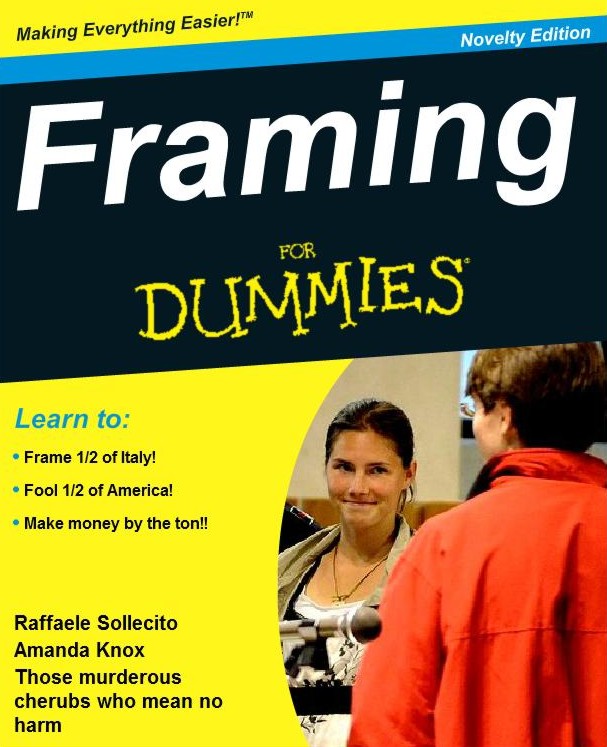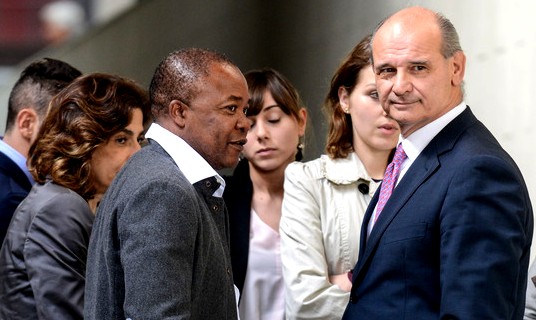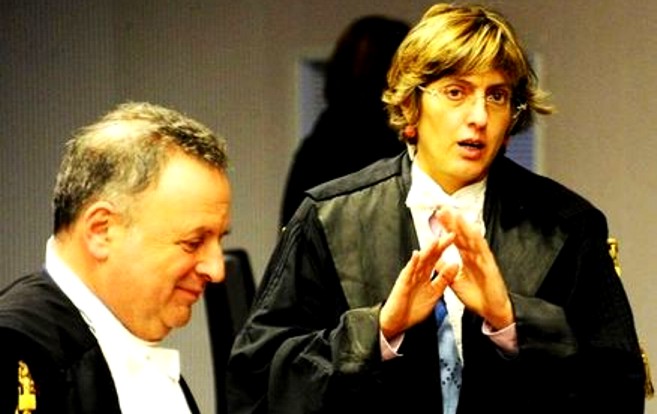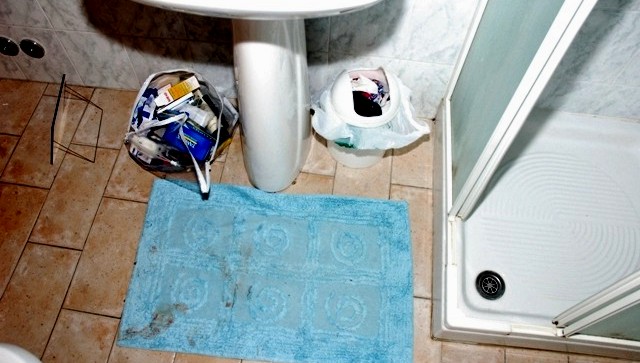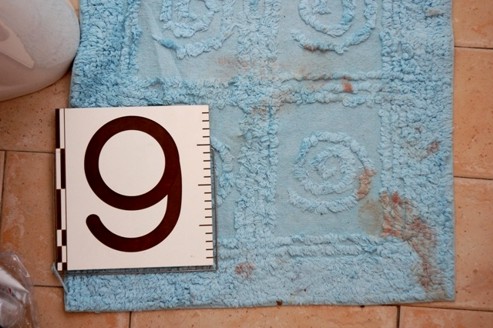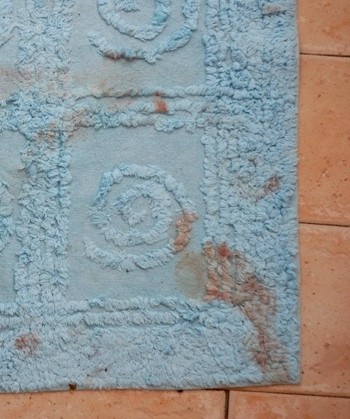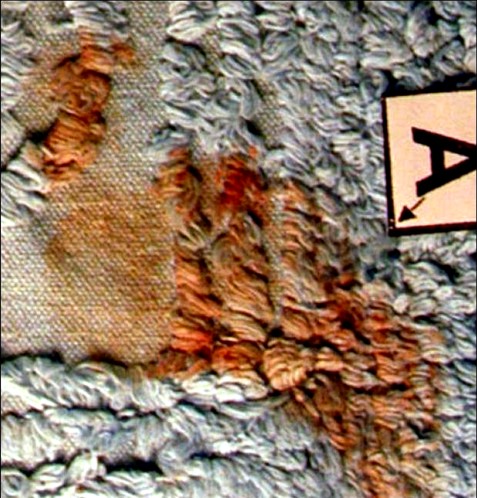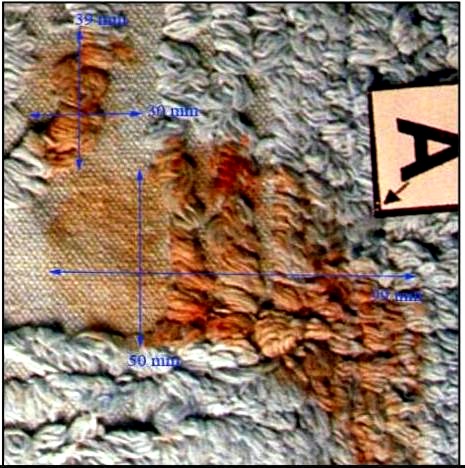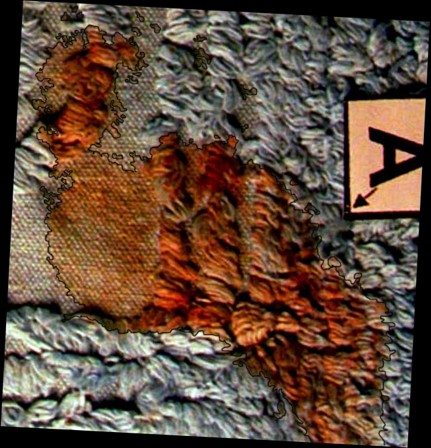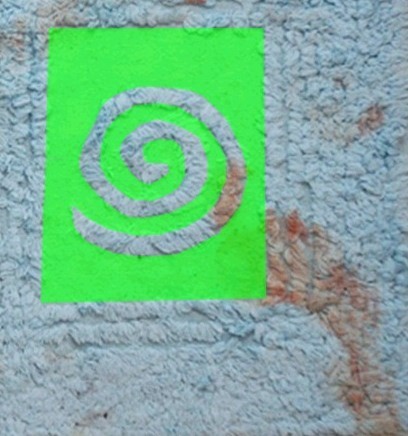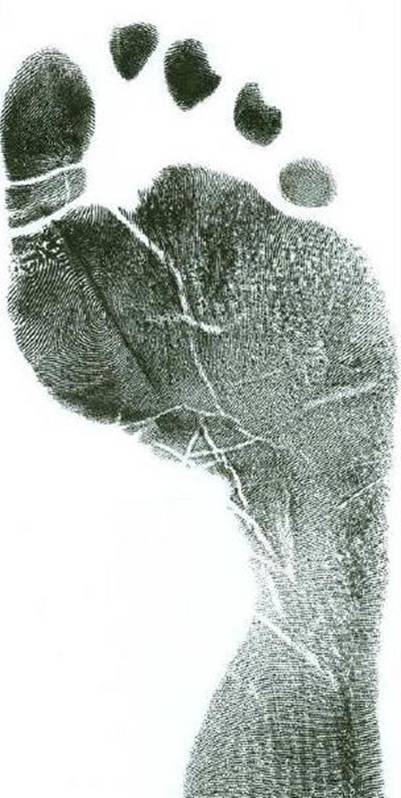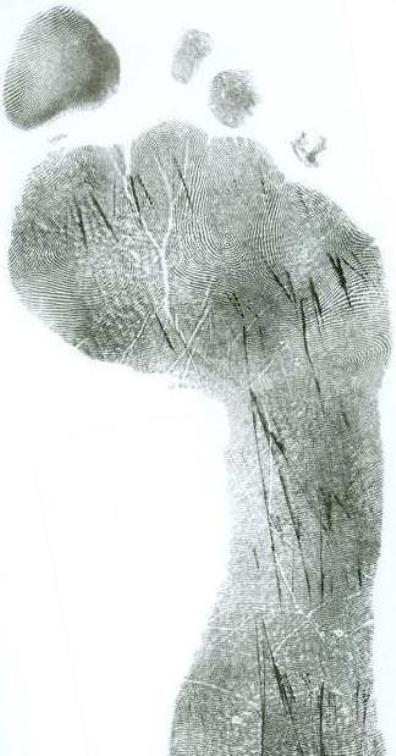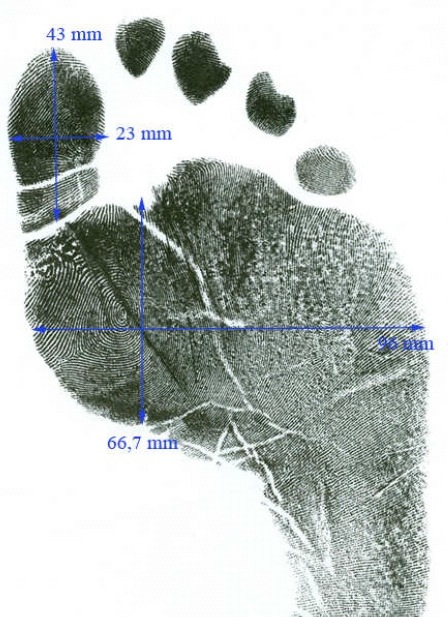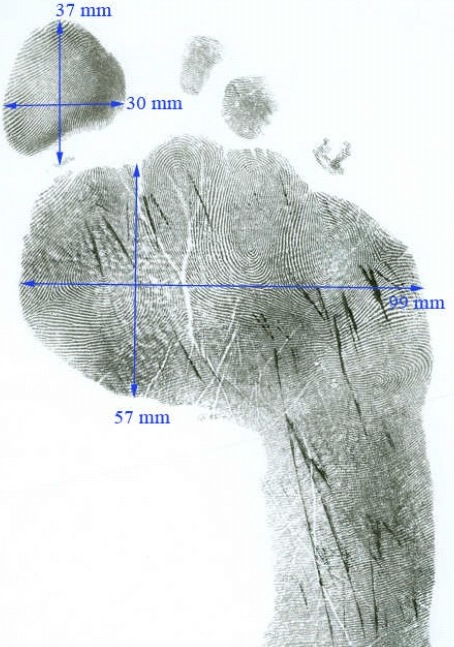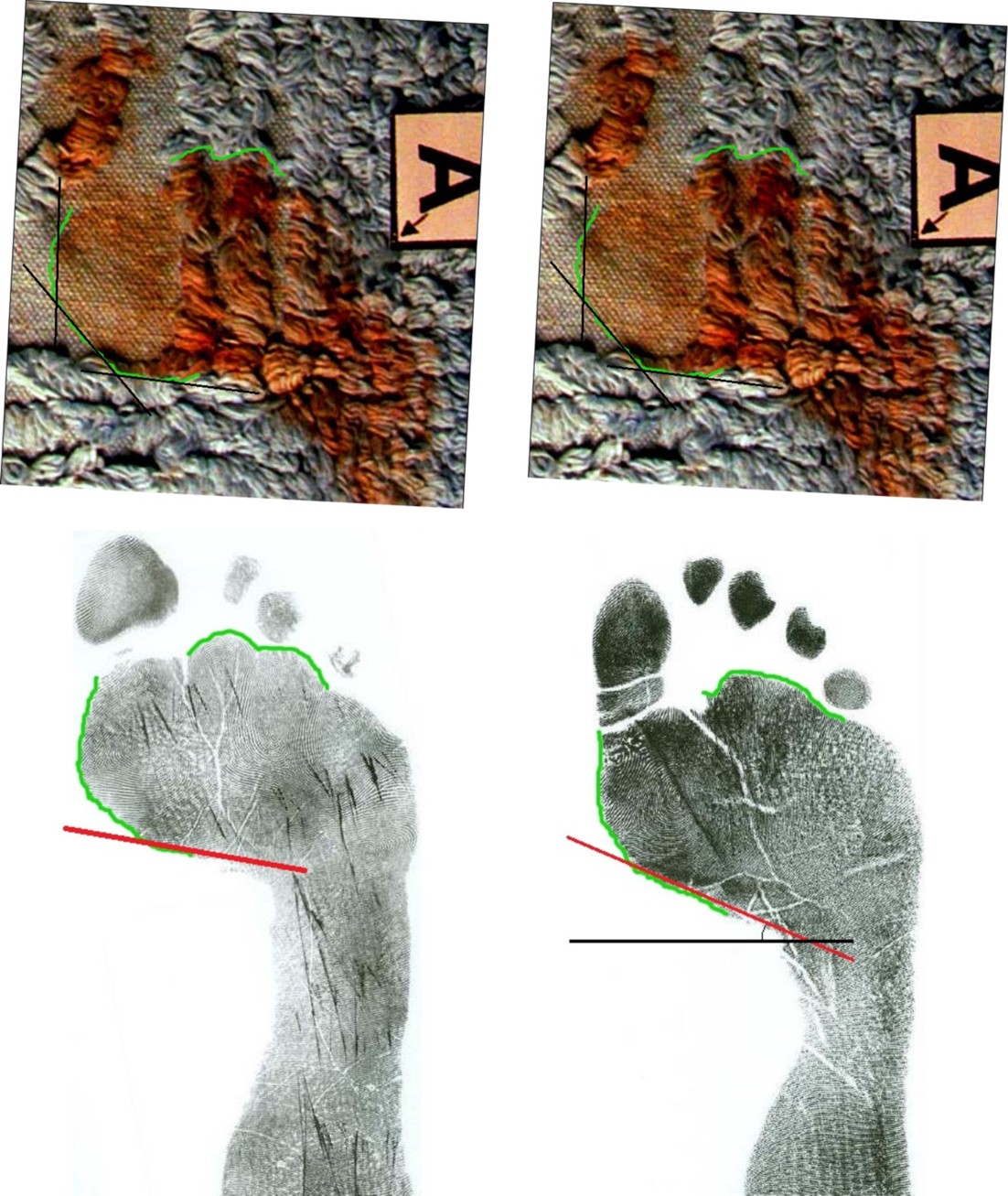
Category: Hoaxers from 2007
Thursday, May 22, 2014
The Cuomo Interview: Why This May Be The Last Time Knox Tries To Argue Innocence On TV
Posted by Vivianna
Concepts of innocence
I want to make the distinction here, as in some of my previous posts, between factual and legal innocence to show how on factual evidence Knox is giving up.
- Factual innocence is what we may consider “true” innocence, i.e. the complete lack of involvement in a crime.
- Legal innocence, on the other hand, is innocence established in a court of law on the basis of a reconstruction of events.
Ideally, the two coincide. But there are certainly cases in which someone who is factually guilty of a crime may be found innocent in a legal sense due to a lack of evidence.
This distinction is important here since the type of innocence Knox appears to want to establish throughout her most recent interview is, surprisingly, legal innocence ““ not factual innocence.
There are signs that Knox knows she’s failed to sell factual innocence, and is losing traction with all crime professionals everywhere - the psychologists are already long gone.
And signs that American big-media fascination has run its course. A few days after the release of the Nencini motivation report, Knox was interviewed by Chris Cuomo on CNN. This was the one big Knox-camp response to the report - and the main airing of the interview was just after 6:00 am. A video of some highlights can be viewed on the CNN website after the brief ad.
I would like to refer you at the start to this excellent post by Eyes for Lies, who has been praised on TJMK before. The transcribed quotes below are taken from the Eyes for Lies blog and they are accurate; their accuracy can be confirmed by listening to the interview linked above.
“This judge’s motivations…”
The first thing you may notice when you watch the interview is Knox’s difficulty to form articulate sentences. This is not a comment on her intelligence or her ability to speak in public, but it appears odd considering her coaching and the number of interviews she has given before.
She pauses often and constantly reforms her sentences, perhaps realizing that what she wants to say may not play out in her favor. As a result, she uses vague and sometimes unusual language, and her sentence fragments reveal aspects which she is otherwise attempting to conceal.
This inability to effortlessly stick to her script in a somewhat tense scenario betrays the fact that there is a discrepancy between her beliefs and her public statements. It also begs the question of why someone who is supposedly telling the truth needs to construct her answers so carefully if she has nothing to hide.
Cuomo begins the interview by asking Knox why she thought that this judge [Nencini] went further than any other. Here is Knox’ answer, preceded by a rather odd smile:
I”¦believe”¦I mean, I can’t speculate what this judge’s motivations”¦personal motivations or otherwise”¦What I can say is that”¦as”¦this”¦case”¦has progressed”¦”¦.the evidence”¦that the prosecution has claimed exist against me”¦.has been”¦has been proven less and less and less.
The quote of Knox above is a good example from the legal v factual innocence point of view. First, let’s look at the opening few words.
She begins by saying “I believe”¦” and then stops. Evidently, only Knox knows what exactly she intended to say, but it’s rather obvious from her next sentence that what she wanted to say about the judge was not particularly flattering or diplomatic. Given her current situation and the pending defamation suits, she probably thought it was not a good idea to be direct.
Hence, she rephrases on the fly and goes on say that she couldn’t comment on his motivations, while doing this nevertheless towards the end of her sentence. This is known as “paralipsis” which is stating something (which sometimes may be considered an ad hominen) while pretending not to do so.
The fact that she mentions Judge Nencini’s “personal motivations or otherwise” implies that his decision may have not been objective, but based on a personal bias against the defendants (an idea that Ms. Bongiorno has been unsuccessfully trying to flog after the verdict).
“Diminishing evidence…”
Moving on, she makes the first appeal to the legal innocence I mentioned above. Instead of clearly stating that she was innocent or that she did not kill Meredith, Knox prefers to focus on the fact that the evidence against her has been allegedly diminishing.
For one, this is false, as no piece of evidence at all has been dismissed; on the contrary, the new DNA test results from the Carabinieri lab could be considered as additional evidence. So Knox is blatantly lying about something which can be factually disproved, which immediately raises the question of what else she could be lying about.
Secondly, what makes this statement odd is the fact that she does not assert her factual innocence. As someone who was supposedly wrongly accused and against whom there is evidence, whether or not she chooses to acknowledge it, the one thing she has control over is the inner knowledge of her own factual innocence.
That kind of knowledge, in someone who was not subjected to torture or brainwashing, should be untouchable ““ absolute. No matter what anyone said she did, if she knew for a fact that she hadn’t done it, she would be stating it at every opportunity.
The fact that she chooses not to do this indicates that Knox herself may have trouble keeping up this pretense of innocence, especially if she is privately plagued by fear and perhaps guilt or remorse (although she hasn’t shown any signs of the latter). It has been suggested that she may be at a point where she has convinced herself of an alternate truth, but based on what she says, I am uncertain that she genuinely believes what she says.
“I did not kill…”
Only in her next sentence does she finally offer a denial ““ unfortunately couched in vague language which undermines her point.
I did not kill my friend. I did not wield a knife. I had no reason to.
Simple, straight sentences like these are the kind we would expect from an innocent person. The problem lies in the fact that, throughout this interview, Knox never clearly states, “I did not kill Meredith.” I don’t think Knox is lying when she says “I did not kill my friend,” since, strictly speaking, she did not kill any of her friends.
The problem is that Meredith was not her friend, even if both she and Meredith may have acted friendly towards each other at the beginning. Based on statements given by Meredith’s English friends and by her family, Meredith was irritated by Amanda’s behavior and frequently complained about the latter’s habits (untidiness, dirtiness, attention-seeking, bringing strange men to the apartment, etc).
Meredith probably maintained a civil front in order to avoid tension, but she had already started to distance herself. The fact that she did not return Amanda’s texts on Halloween demonstrates that she wanted to spend time with her actual friends, rather than have to deal with Knox’ histrionic episodes. Given the social nature of Halloween in a college town, this situation would not have occurred if the two had really been close prior to the murder.
“I did not wield a knife” is a blatant lie, since Knox’ DNA was found on both the handle and blade of the kitchen knife. Eyes for Lies found it strange that Knox even mentioned the knife in light of her innocence claim, but I think it makes sense because the knife figured prominently in the appeal proceedings.
Or rather, it makes sense for someone who is focused on the legal innocence aspect mentioned above. Knox equates being found innocent with being innocent, as we’ll see below, so it’s important for her to address the evidence (without realizing that, by doing so, she is acting in ways which are not consistent with factual innocence).
“My friend…”
Returning to “my friend,” we see the beginning of a trend which continues throughout the interview. Knox has a tendency to refer to Meredith obliquely ““ rarely by name.
This manifests itself in several ways: by exerting ownership (“MY friend”) or by referring to her as an inanimate object (which we’ll see happening in the following paragraphs). Considering that murder is a total, irreversible way of taking away someone’s personhood, this constant appropriation and objectification are disturbing and belie Knox’s supposed fondness for Meredith.
Next, Knox says, “I”¦.I was”¦in the month we were living together, we were becoming friends.”
Here I agree with Eyes for Lies’ argument that perhaps what Knox started saying was “I was trying to be friends with her.” Note that she says “we were becoming friends,” not “we were friends.” This calls into question her truthfulness when she calls Meredith “my friend.”
By Knox’ own admission, they were not quite friends yet at that point - or rather, not anymore, since the disagreements had already started; once again, Knox distorts the truth by making it seem that they were getting closer rather than as in reality growing apart.
A week before the murder occurred, we went out to a classical music concert together. Like”¦we had never fought. There is no trace of us.
The part about the concert is true (this is where Knox met Sollecito). We don’t know why Meredith left before the concert ended: perhaps she was tired, she had to study, or didn’t particularly enjoy the music; it’s also possible that she may have felt irritated with whatever Knox was doing to attract Sollecito’s attention.
Given his inexperience and lack of confidence at the time, Sollecito would have most likely not approached Knox without an invitation, but that’s a matter for another post.
“Like “¦ we had never fought” can be interpreted in two ways. One: we can read it as “we went out [”¦] together like we had never fought”; this implies that they did fight, which would be true, but that they were working on settling their differences. Two: “like” could be a simple filler word, and we should read it as “we had never fought,” which would be false. I’m not sure which way she meant it, so I’ll leave it at that.
“There is no trace…”
It seems like Knox jumps to saying “there is no trace of us,” but the video posted online was edited, and not very smoothly. You can see the transition, so she must have said this after additional remarks or in response to a different question. Hence, the fact that it seems random isn’t probably her fault.
It’s interesting in itself though because it’s another instance of her lying about verifiable facts (see judges’ reports and the numerous posts regarding forensic evidence). Also, it’s an important statement in conjunction with the infamous quote about Meredith’s “broken body” because it once again equates lack of evidence with innocence, rather than directly stating innocence.
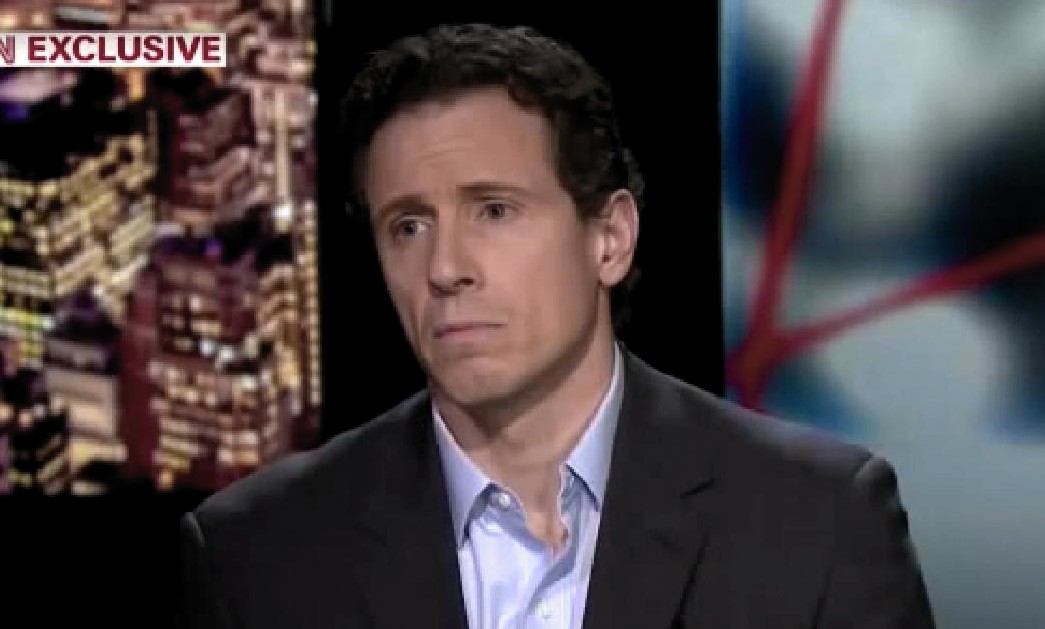
“If Guede committed…”
This is perhaps the most controversial part of the interview and also the part which ties things together (the idea of legal innocence and the objectification of Meredith).
If Rudy Guede”¦committed this crime”¦which he did”¦we know that because his DNA is there”¦on the”¦on Meredith’s body, around Meredith’s body. His hand prints and foot prints in her blood. None of that exists for me and if I were there, I would have had traces of”¦Meredith’s broken body on me”¦and I would have left traces of myself”¦.around”¦around Meredith’s corpse”¦.and I”¦I am not there”¦and that proves my innocence.
She starts her response with something which is both incredibly revealing and absolutely shocking for someone who claims innocence - “If Rudy Guede committed this crime.”
I don’t think anyone has questioned Guede’s involvement in this murder, even if the precise extent of it remains unclear, and the two have partially built their defense around the lone wolf scenario. Also, since Guede’s verdict was issued and confirmed years ago, Knox does not need to pussyfoot around his status for fear of slander charges.
Knox is not talking about Guede’s involvement in general terms, however. She’s explicitly referring to him actually committing the crime (i.e. inflicting the lethal wounds). Her hesitation betrays the fact that she doesn’t believe he did.
Of course, she catches herself: “which he did “¦ we know that because his DNA is there.” It’s interesting she has to point out how she knows this ““ from reading the evidence, certainly, not from being there and therefore knowing for a fact that he participated in the assault, but not in the actual murder.
“On the… Meredith’s body”
Next, we have another instance of objectification: “”¦on the”¦on Meredith’s body, around Meredith’s body.” Perhaps she wanted to say “on the corpse” and thought it might be a bit inconsiderate, so she switches to the more neutral “body,” only to use the implied word a few sentences later. However, what’s striking about it is that she thinks of Meredith as a body, not as a person.
I want you to think about the time you lost a friend or a family member, regardless of circumstances. Did you ever think of them as a body, or did you continue to think of them as they were in life, even if you had to identify them or take care of funeral arrangements? I’m not asking this rhetorically, by the way.
When my father died (rather suddenly, but due to illness), it never ever crossed my mind to think of him as a body, but perhaps circumstances alter perceptions. I’ve also read numerous things written by Meredith’s friends and family, and they always refer to her as “Meredith” or “Mez.” To them, she never stopped being a person because they loved her, and diminishing her would have been inconceivable.
I think it’s far more likely that the word “body” will appear in a military, medical, or anthropological context, in which there is no personal connection between the observer and the dead. We may use this word ourselves when talking about the crime scene, but it’s rather telling that we use her name far more often than someone who actually knew her in life.
I can’t know what Knox felt about Meredith, but there is no indication it was positive. The clinical and graphic manner in which she refers to “Meredith’s body,” “broken body,” and “corpse” betrays an obstinate refusal to acknowledge her as a person. Why, if Meredith was indeed her friend as she insists?
For one, it suggests that Knox actually saw Meredith being transformed into a “body” and that this image stuck with her. Let’s not forget that Knox never saw Meredith after the latter was discovered; based on the statements of the other people present in the cottage, she was not near the door when it was broken open, and she was also not asked to identify Meredith.
The only way an innocent Knox could have seen Meredith after her death would have been in photographs presented in court. There is no doubt that such photographs can be disturbing and upsetting, but I don’t think they can supplant memories of actual experiences.
Secondly, it’s a form of denying someone’s personhood and of expressing power and domination. A murderer can literally deprive someone of personhood ““ an act which they may feel triumphant about, especially if the person was a source of distress in life. I can’t help feeling that Knox is gloating when she mentions Meredith’s body.
Thirdly, refusing to name the victim and to refer to her as a person is a way of preventing her from taking center stage. While Knox has repeatedly complained about the media attention she has received, both she and her campaign have fought really hard to marginalize and displace Meredith in an attempt to replace the tragedy of the latter’s death with the supposed tragedy of Knox’ unwarranted imprisonment.
It must be disappointing when someone you’ve risked everything to eliminate continues stealing your thunder, so Knox isn’t letting us forget the actual state of things: she is there, in a TV studio, enjoying the luxury of being an “I,” while Meredith has been reduced to an “it” ““ a broken body.
The words she uses to refer to Meredith, whether graphic or macabre, suggest disgust with the physicality of death. Perhaps Knox just wanted Meredith to go away forever and found it difficult to deal with the aftermath of a violent murder.
“None of that exists…”
Returning to the issue of legal innocence, Knox claims that Guede’s hand and foot prints were identified, while “none of that exists for me”; also, “I would have left traces of myself”¦.around”¦around Meredith’s corpse.”
These are further lies, since a size 36-38 foot print was identified, and Knox was the only one it could have belonged to. There were also five mixed DNA spots (comingled blood from both women), which, just because they were not right next to Meredith’s body, cannot be dismissed.
The crime scene covers the entire house as far as the police and the court are concerned. How anyone else defines the crime scene is of no consequence at all.
“[”¦] if I were there, I would have had traces of”¦Meredith’s broken body on me,” she says next. This is, of course, an impossible scenario since Meredith was discovered long hours after her death and it was days before police looked at her.
In the meantime, a clean up had unquestionably taken place, and Knox herself admits to having showered (perhaps not in the morning as she wrote in her email, but earlier that night). Also, Knox was initially considered a witness, not a suspect, and her person and clothes were not immediately swabbed by the scientific police.
She’s trying to make it sound like no traces were discovered on her, but in fact no one tested for this and no one can prove it either way.
“I am not there…”
She continues: “I”¦I am not there”¦and that proves my innocence.” By “I am not there,” she means that incriminating traces were not found at the scene, not that she wasn’t there on that night. Note the difference between “I am innocent,” which she does not say, and “[the lack of evidence] proves my innocence.”
In other words, she’s insisting on legal innocence, but doesn’t actually confirm her factual innocence. The problem with that is since she’s lying about the factual evidence, it’s difficult to take her legal innocence claim seriously.
“Possible to win…”
At the end of the interview, she says, “I truly believe it is possible to win this and to bring”¦to bring an end to all of the speculation and the nonsensical theories and really bring peace to everyone who has suffered from this experience.”
The use of the word “win” here is peculiar, to say the least. It’s consistent with her competitive attitude towards Meredith, for one ““ killing her and getting away with it, regardless of the sacrifices made on the way, would constitute a sort of victory, I suppose.
It also has the implication of “winning the case,” which we may expect from a lawyer or someone for whom this is a professional, rather than personal undertaking. A wrongfully accused and imprisoned person has nothing to win in the end, considering the traumas they suffered; the most they can hope for is recognition and vindication.
She is correct, however, that it’s possible to end the speculation and theories. However, that would require her, Sollecito, or Guede to tell the truth about what happened on that night. In this, she has full agency ““ this is not something that can be done for her, but something which she needs to do herself.
Other than that, the “speculation and nonsensical theories” refers to the judges’ reports, in addition to lay commentary; her problem is that saying something is “nonsensical” doesn’t automatically render it so in the absence of arguments and proof (none of which she or her defense have been able to provide).
“Peace to everyone…”
“[”¦] really bring peace to everyone who has suffered from this experience” ““ this has to be one of the blindest and most self-centered things Knox has ever said about the case.
For one, it’s doubtful that a favorable verdict would even bring peace to her and Sollecito, since they will always know what they’ve done, even if they don’t have to fear imprisonment anymore. It might or might not bring peace to their families, who have already spent a fortune on their defense and whose trust has probably been shattered forever.
However, to imply that it would bring peace to Meredith’s family and friends is both presumptuous and contemptible.
Knox and her arrogant followers have, on numerous occasions, taken it upon themselves to speak for the Kerchers ““ how they should feel, what they should accept, etc. First pioneered by the contemptible Candace Dempsey, it is incredibly disrespectful to people who have suffered a great, irreplaceable, undeserved loss and who have done nothing wrong by pursuing justice for their loved one.
The fact that Knox and Sollecito have refused to confess for the past seven years has done nothing but prolong the suffering of Meredith’s family by denying them closure and the necessary space to mourn and heal.
Conclusions
what we have here is a number of outright lies, some distortions, and some false starts which help pinpoint what Knox believes, rather than what she says. What we don’t have is a plea for factual innocence, but an attempt to prove legal innocence by glossing over the evidence or dismissing it altogether, and by calling into question the judges’ professionalism. We also see no evidence of respect or compassion for Meredith, but rather an attempt to objectify and incorporate her in Knox’ own story.
My impression is that Knox does not believe the things she says herself and is struggling to maintain a front; that despite her coaching and experience with interviews, she is getting ahead of herself instead of simply reciting her lines, which denotes anxiety and conflict. I don’t believe she’s at peace with the murder at least, which hopefully means that at some point she might be inclined to confess.
Sunday, May 18, 2014
Knox Interrogation Hoax #4: More Hard Realities From Rita Ficcara, Nervousness From Defense
Posted by Our Main Posters
1. Overview of this hoax series
Knox turned up at the central police station unwanted late on 5-6 Nov 2007 and briefly helped police with a list of seven names. Her version of this has morphed into a gigantic hoax.
One highly consistent version of the brief chat was testified to by all those officials present, and accepted by all courts including the Italian Supreme Court. Knox has served three years in prison for it and the US Embassy saw nothing done wrong.
And then there is Knox’s endlessly shifting version, inflated opportunistically and erratically by herself and wannabee experts over nearly seven years now. Knox has done so in numerous interviews, in her 2013 book, on her website, in her email to Judge Nencini, and in her “appeal” to the European Court of Human Rights. And the PR shills have done so on websites, on TV, in books, and in attempts to lobby the US federal government.
This version was repudiated several times by her smart Italian lawyers (though not by her foolish American lawyers) and they did next to nothing to try to verify it when questioning those officials at trial.
See a longer summary in Post #1 here.
2. Continuing the cross-examination of Rita Ficarra
Below is the examination of Inspector Rita Ficarra by Carlo Pacelli, Patrick Lumumba’s lawyer. Very tough stuff. Chronologically, this preceded the defense cross-examinations in posts #2 and #3 and may well have dampened them.
Here “GCM” is Judge Massei. As the defenses fully acknowledged, this was merely a recap/summary, a simple checking of facts with someone who might be helpful which could have been done on a street corner. It was not a witness or suspect interrogation. Claims that it was are a key part of the great hoax.
This English translation of the relevant part of Rita Ficarra’s testimony on 28 February 2009 was by main poster and professional translator ZiaK. Her full translation will appear soon on the Meredith Case Wiki.
Please click here for more
Thursday, May 15, 2014
Knox Interrogation Hoax #3: Timid Defense Pussyfooting Toward Rita Ficcara, Key Witness
Posted by Our Main Posters
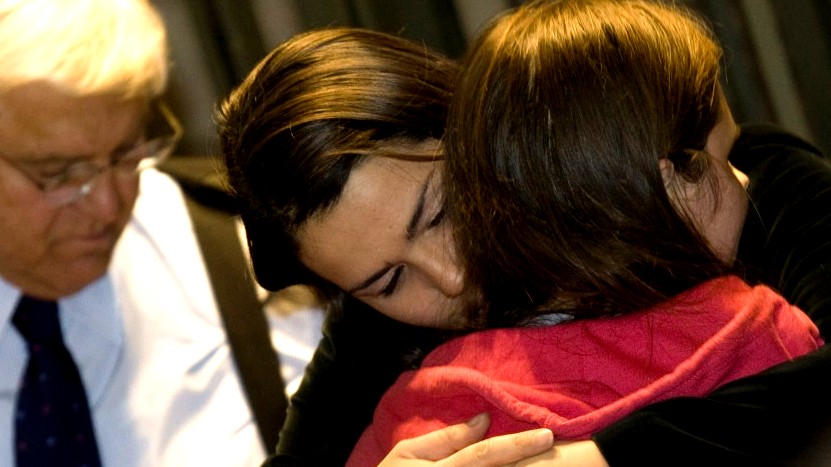
([Amanda Knox’s lawyers Luciano Ghirga and Maria Del Grasso who questioned Rita Ficarra]
1. Overview of this hoax series
Knox turned up at the central police station unwanted late on 5-6 Nov 2007 and briefly helped police with a list of seven names. Her version of this has morphed into a gigantic hoax.
One highly consistent version of the brief chat was testified to by all those officials present, and accepted by all courts including the Italian Supreme Court. Knox has served three years in prison for it and the US Embassy saw nothing done wrong.
And then there is Knox’s endlessly shifting version, inflated opportunistically and erratically by herself and wannabee experts over nearly seven years now. Knox has done so in numerous interviews, in her 2013 book, on her website, in her email to Judge Nencini, and in her “appeal” to the European Court of Human Rights. And the PR shills have done so on websites, on TV, in books, and in attempts to lobby the US federal government.
This version was repudiated several times by her smart Italian lawyers (though not by her foolish American lawyers) and they did next to nothing to try to verify it when questioning those officials at trial.
See a longer summary in Post #1 here.
2. Continuing the cross-examination of Rita Ficarra
In our hoax series second post we quoted two cross-examinations of Rita Ficarra by Sollecito’s lead lawyers. Here we quote two more, by two of Knox’s lawyers, Luciano Ghirga, and Maria Del Grasso.
Here “GCM” is Judge Massei. As the defenses fully acknowledged, this was merely a recap/summary, a simple checking of facts with someone who might be helpful which could have been done on a street corner. It was not a witness or suspect interrogation. Claims that it was are a key part of the great hoax.
This English translation of the relevant part of Rita Ficarra’s testimony on 28 February 2009 was by main poster and professional translator ZiaK. Her full translation will appear soon on the Meredith Case Wiki.
Please click here for more
Tuesday, May 13, 2014
Knox Interrogation Hoax #2: Trial Testimony From Rita Ficcara On Realities 5-6 Nov
Posted by Our Main Posters
1. Overview of this hoax series
Knox turned up at the central police station unwanted late on 5-6 Nov 2007 and briefly helped police with a list of seven names. Her version of this has morphed into a gigantic hoax.
One highly consistent version of the brief chat was testified to by all those officials present, and accepted by all courts including the Italian Supreme Court. Knox has served three years in prison for it and the US Embassy saw nothing done wrong.
And then there is Knox’s endlessly shifting version, inflated opportunistically and erratically by herself and wannabee experts over nearly seven years now. Knox has done so in numerous interviews, in her 2013 book, on her website, in her email to Judge Nencini, and in her “appeal” to the European Court of Human Rights. And the PR shills have done so on websites, on TV, in books, and in attempts to lobby the US federal government.
This version was repudiated several times by her smart Italian lawyers (though not by her foolish American lawyers) and they did next to nothing to try to verify it when questioning those officials at trial.
See a longer summary in Post #1 here.
2. The Testimony Of Inspector Rita Ficarra
Inspector Rita Ficarra was the one who initiated and led the discussion with Knox up to when Knox made her first statement, the first implicating Patrick Lumumba.
What follows is the cross-examination of Inspector Ficarra by the prosecution and all four cross-examining defense lawyers.
It would have been a really huge gain for the defenses at trial - a not-guilty verdict would have been almost guaranteed - if they had rattled Rita Ficarra and had her admit to Knox’s coercion. Especially by the supposed alternating tag teams. Especially of a Knox without food, drink, sleep, or breaks for the bathroom.
But note that in their cross-examinations NOT ONE defense lawyer even tried to go there. In their questioning of Rita Ficarra, that mundane scenario of the two brief sessions we describe above seems a given - their own sticking point.
Here “GCM” is Judge Massei. As the defenses fully acknowledged, this was merely a recap/summary, a simple checking of facts with someone who might be helpful which could have been done on a street corner. It was not a witness or suspect interrogation. Claims that it was are a key part of the great hoax.
This English translation of the relevant part of Rita Ficarra’s testimony on 28 February 2009 was by main poster and professional translator ZiaK. Her full translation will appear soon on the Meredith Case Wiki.
Please click here for more
Sunday, May 11, 2014
Knox Interrogation Hoax #1: Masterlist Of Posts Re Pre-Trial Events And Hoax Overview
Posted by Our Main Posters

Perugia Central Police Station at night (left-center)
1. Masterlist Of Posts In The Series
The Interrogation Hoax series will consist of a total of 24 posts.
These posts quote from a large number of transcripts only recently acquired and translated. There are no serious conflicts, no gray areas. One can assume with total certainty that this is the real thing (see Part 3 below), and that any other versions (see Part 4 below) are fabricated.
Numbering of posts 1-24 is not chronological, it represents the original order of postings.
1. What Happened At AK & RS Q&A Prior To 6 Nov
Click for Post: #19: ALL Knox Q&A Sessions 2-6 November 2007 WERE Recorded #1
Click for Post: #20: ALL Knox Q&A Sessions 2-6 November 2007 WERE Recorded #2
2. What Happened At Knox Q&A 6 Nov Ending 1:45 AM
Click for Post: #2: Trial Testimony From Rita Ficcara On Realities 5-6 Nov
Click for Post: #3: More Defense Pussyfooting Toward Rita Ficcara, Key Witness
Click for Post: #4: More Hard Realities From Rita Ficcara, More Nervousness From Defense
Click for Post: #12: Ficarra & Knox Notes PROVE Knox Merely Worked On Visitors Names List
Click for Post: #5: Key Witness Monica Napoleoni Confirms Knox Self-Imploded 5-6 Nov
Click for Post: #7: Testimony Of Witness Lorena Zugarini On The Knox Conniption 5-6 Nov
Click for Post: #8: Testimony Of Interpreter Donnino On Events Night Of 5 November
3. What Happened At Sollecito Q&A 6 Nov Ending 3:30 AM
Click for Post: #6: Sollecito Transcript & Actions Further Damage Knox Version
Click for Post: #9: Officer Moscatelli’s Recap/Summary Session With Sollecito 5-6 Nov
4. What Happened At Knox-Rights Session Ending 5:45am
Click for Post: #15: Knox Is Told Her Rights And Repeats Fake Murder Charge
5. What Of Relevance Happened In Ensuing Months
Click for Post: #13: The First Two Pre-Trial Opportunities Which Knox Flunked
Click for Post: #14: The Third Pre-Trial Opportunitty Which Knox Flunked
Click for Post: #16: The Fourth Pre-Trial Opportunity Which Knox Flunked
Click for Post: #17: Sollecito April 2008 Before Supreme Court Again Coldshoulders Knox
Click for Post:#18: The Final Pre-Trial Opportunities Which Knox Flunked
Click for Post: #21: Illustrating How Batshit Crazy The Interrogation Hoax Has Become
6. Why Investigators’ Version Won Hands-Down At Trial
Click for Post: #10: Why Prosecution And Defenses Never Believed Knox’s Version #1
Click for Post: #11: Why Prosecution And Defenses Never Believed Knox’s Version #2
2. Explaining Overall Arc Of Events
Much of the testimony listed above was about events at the central police station pre-arrest in early November 2007 and subsequent court attempts to achieve some believability and relief.
Early in 2009 at trial Knox and Sollecito sat glumly through all of the investigators’ pre-arrest testimony and cross-examination at trial. They were downhearted and apprehensive, and there were no smiles and few interruptions.
Subsequently Sollecito chose not to get on the stand, so from his team there really was never a rebuttal.
But Knox HAD to get on the stand, in July, for two days. She had no other way to defend herself against the serious felony crime of falsely framing Patrick for murder.
It was her word against theirs. It contradicted in many places what she had heard months earlier in sworn testimony from many investigators.
Knox’s version inevitably weakened a lot under cross-examination, and was ultimately a fail at trial and several appeals, even the annulled one.
Knox ended up serving three years. While on the stand she confirmed that she had been treated well, stiffing thousands of supporters duped into believing she had not been.
3. Explaining Court-Accepted Narrative For 6 Nov
This is an overview of Knox’s so-called “interrogation” at Perugia’s central police station, the subject of the first ten posts.
It led to her arrest and three years served. To make this picture really firm we will quote a lot of the testimony at trial. The Case Wiki carries all of these transcripts, many in English translation, and more.
Senior Inspector Rita Ficarra testified that she arrived back at the police station late on 5 November, and finds her way blocked by a cartwheeling Knox.
She rebukes Knox, who testily responds that she is tired of the investigation. Rita Ficarra tells Knox to go home and get some sleep. Knox testily refuses, and remains there.
Shortly after, Ficarra suggests to Knox that if she really wants to help, she could add to the list of possible perps - men who Meredith knew and who might have visited the house.
This was a recap/summary, a simple checking of facts with someone who might or might not be of help. This could have been done on a street corner or in a house by a single officer. It was not a witness or suspect interrogation. From the transcript:
Ghirga: “While this interrogation - let’s call it thus - was in progress, some colleagues arrive…” Ficarra: “It was not an interrogation, Attorney.” Ghirga: “They are called recaps/summaries.
Knox eagerly agrees. So they begin on the list.
This goes slowly because of language problems, until an interpreter, Anna Donnino, arrives. In total only Knox and four others (three of them women) are present.
Knox builds a list of seven people and adds maps and phone numbers (placed in evidence) in a calm proceeding. These were the names: Peter Svizzero, Patrick, Ardak, Juve, Spiros, Shaki and “a South African [Guede]” who played basketball near the house.
At several points in the evening Knox is provided with refreshments. No voices are ever raised, no bathroom breaks are refused.
In a separate wing Inspector Napoleoni and a couple of colleagues are seeking facts from Sollecito. Shown conflicts between what he has said and what his phone records show, Sollecito backtracks, and declares that Knox went out alone on the night, and made him lie.
Napoleoni moves through the questura to suggest to Ficarra to discuss the night of the attack with Knox in more detail and clarify who might have been present. Knox is not informed of Sollecito’s backtrack. She is asked for more names and spontaneously shares her phone. There is an outgoing to Patrick but no prior incoming. Knox is asked who Patrick is.
Suddenly, to the considerable surprise of others present, Knox has a yelling, head-clutching conniption (the first of several that night) and says “It’s him, it’s him, it was him, he killed her”. The session is halted.
Despite warnings she should not do so without a lawyer, Knox insists on a recorded statement which says she headed out to meet Patrick that night after he texted her. She accuses Patrick of killing Meredith.
Efforts are made throughout the next several hours to try to help Knox to calm down. Knox is put on hold, given more refreshments, and made comfortable on some chairs so she might try to get some sleep.
A second session ending at 5:45 is intended as merely a formal reading of Knox’s legal status and her right to a lawyer, with Dr Mignini presiding. She is to be held as a material witness and for her own protection.
Again warned that she should not speak without a lawyer, and no questions can be asked, Knox still insists on a second spontaneous accusation culminating in a second recorded statement.
This also says she went out to meet Patrick that night, also accuses Patrick of killing Meredith, and now also hints that Sollecito may have been there.
Just before noon, now under arrest and about to be taken to Capanne Prison, Knox insists on writing out at length a third statement this time in English.
She gleefully hands it to Rita Ficcara who cannot read it as she as no English. In the statement, Knox included this damning remark, without any mention of having been coerced: “The questions that need answering, at least for how I’m thinking are… 2. Why did I think of Patrik?”
Knox’s lawyers never ever substantially challenge this version, and never lodge any complaint. At trial in 2009 they accept on the record that there was no interrogation, and leave standing that Knox insisted on all three statements, and dont ever pursue Knox’s claims that she was coerced.
Courts all noted that there is no mention in that third note of Knox having been coerced, although this note was her idea and she could put in it anything she liked. From this there never was any going back.
In July 2009 at trial, in face of days and days of prior investigator testimony, Knox brashly tried to substitute this scenario above with the one below. Of course she was disbelieved.
For the calunnia framing of Patrick Lumumba Judge Massei in 2009 sentenced her to a year more than Sollecito, amended by Judge Hellmann in 2011 to three years served.
The Supreme Court definitively overruled her calunnia appeal so for her false framing of Patrick she is a felon for life.
4. Explaining Knox Family & PR Alternative
Knox’s Italian lawyers were not a part of this; in contrast the American PR lawyer Ted Simon sought to introduce major confusion.
In Italy, lawyers are REQUIRED to report tales of abuse of their clients or face possible criminal charges. Contrariwise, if they knowingly report false charges they can face similar charges. So what they do is a strong indicator of truth.
Amanda Knox’s lawyers not only did not ever report any abuse. They even announced publicly, in face of incessant claims of abuse by Knox, family, and PR forces, that they had seen no evidence of abuse and so would not be reporting.
Though her precise claims vary and often contradict one another, Knox herself has on and off ever since November 2007 tried to put the investigators on trial - tried to blame the police for causing her conniption and her false accusation of Patrick for the death of Meredith.
Her fail rate has been spectacular.
Knox failed to convince (1) Supervising Magistrate Matteini and (2) the Ricciarelli review panel in November 2007, (3) failed to convince Prosecutor Mignini in December 2007, (4) failed to convince the Supreme Court in April 2008, (5) failed to convince the Micheli court in late 2008, (6) failed to convince the judges and jury at trial 2009, (7) failed at annulled appeal 2011, (8) failed at repeat appeal 2013, (9) failed to convince the Supreme Court in 2012 and (10) failed again in 2015.
As Knox’s team simply did not ever believe her, they may not have given this their hardest shot. It was not part of their largely spurious complaint to the EC HR.
And yet despite all of these failures, the huge and very nasty Knox PR effort went full-bore ahead with the abuse allegations anyway.
Read this post of 11 February 2009 which was about two weeks before the Knox “interrogators” were cross-examined at trial, and several months before Knox herself took the stand. Dozens of media reports repeated the Knox claims as if true.
Knox repeated them in her April 2013 book, and her December 2013 email to Judge Nencini, and her appeal to EHCR Strasbourg, and in some TV and newspaper interviews, including one with the Italian weekly Oggi which caused that paper legal harm.
This version has been blown up by Knox PR shills in internet posts, articles, TV interviews, and books. Among others propagating it have been Raffaele Sollecito (in his book), Doug Preston, Saul Kassin, Steve Moore (especially), John Douglas, Jim Clemente, Paul Ciolino, Michael Heavey, Greg Hampikian, Chris Halkidis, Mark Waterbury, Doug Bremner, Candace Dempsey, Nina Burleigh, Bruce Fischer, and many posters on the Knox sites and Fischer sites and on Ground Report.
Main claims included 50-plus hours of “interrogation”, numerous officers in teams, no food or drink, no sleep, no bathroom breaks, no lawyer, no recording, and much abuse and yelling and suggestions and threats. Way beyond anything even Knox herself and notably her own lawyers ever claimed.
- Here is Steve Moore claiming that around a dozen cops in rotating tag teams of two assaulted a starving and sleepless Knox over 20/30/40 hours, threatened her, and refused her a lawyer throughout.
- Here is Saul Kassin claiming that Knox was interrogated over the entire night of 5-6 November, until she was finally broken and a coerced “confession” emerged - even though the “false confession” actually framed Patrick and was in reality a false accusation. That Kassin ignores.
- Here are several former FBI profilers blatantly embellishing the same claims in a book, with (today) 60 five-star reviews.
And yet Knox’s own Italian lawyers specifically denied her accusations! No complaint against the police was ever lodged. All courts disbelieved her. Knox served her three years. But still the PR-driven hoax keeps resounding.
Friday, May 09, 2014
Amanda Knox’s Awkward, Robotic TV Appearances: New Science Could Blow Away Such Fraud
Posted by Peter Quennell
In Italy the zillion or so Italians that Amanda Knox has framed are starting to push back on steroids in the Italian media and courts.
More on that coming up. Meanwhile Americans have been a tad less nimble to realize that they’ve swallowed a gigantic hoax.
Unsurprising, perhaps, given years of uniquely one-sided TV coverage of the case. But thanks to the good English-language reporters in Italy who have persevered. And thanks to CNN’s Nancy Grace for her biting segment this week, making it quite obvious where she stands on guilt.
Knox’s TV appearances and written statements are ringing more and more hollow as they lose all touch with reality. See our post immediately below. Such a brazen mangling of hard facts is absolutely absurd.
The professionals Vivianna and Friendofstfrank, main posters here, each have posts in the works for us on what they have been reading from Knox’s persona on the TV screen.
In the meantime, please check out these videos on the new science. Each is an hour long. They show just how hard it could get for any future Knoxes and Sollecitos to sustain a similar hoax in future.
Here’s an overview of the videos from the New York Times.
The program looks at how developments in neuroscience are affecting court cases and might do so even more radically in the future. It sets up a fictional trial involving a shooting during a convenience store robbery, cutting between courtroom scenes and visits with researchers and legal scholars who are working on the front edge of this world.
By mapping brain activity, scientists know quite a bit about which regions are involved with processes like facial recognition, as well as the differences between mature adult brains and the brains of young people. (The fictional shooting suspect is 18.) The program has segments on how this research might be applied to issues like determining whether a witness is correctly identifying someone, whether a defendant is lying about not having been at a particular location, even whether potential jurors have racial biases.
Researchers, able to see the implications of their work, are also already studying whether knowledgeable test subjects can subvert the technology, rigging test results by how they think or where they focus their eyes.
Tuesday, April 29, 2014
The Nencini Report Complains About Multiple Instances Of Evidence Tampering And Criminal Slander
Posted by Our Main Posters
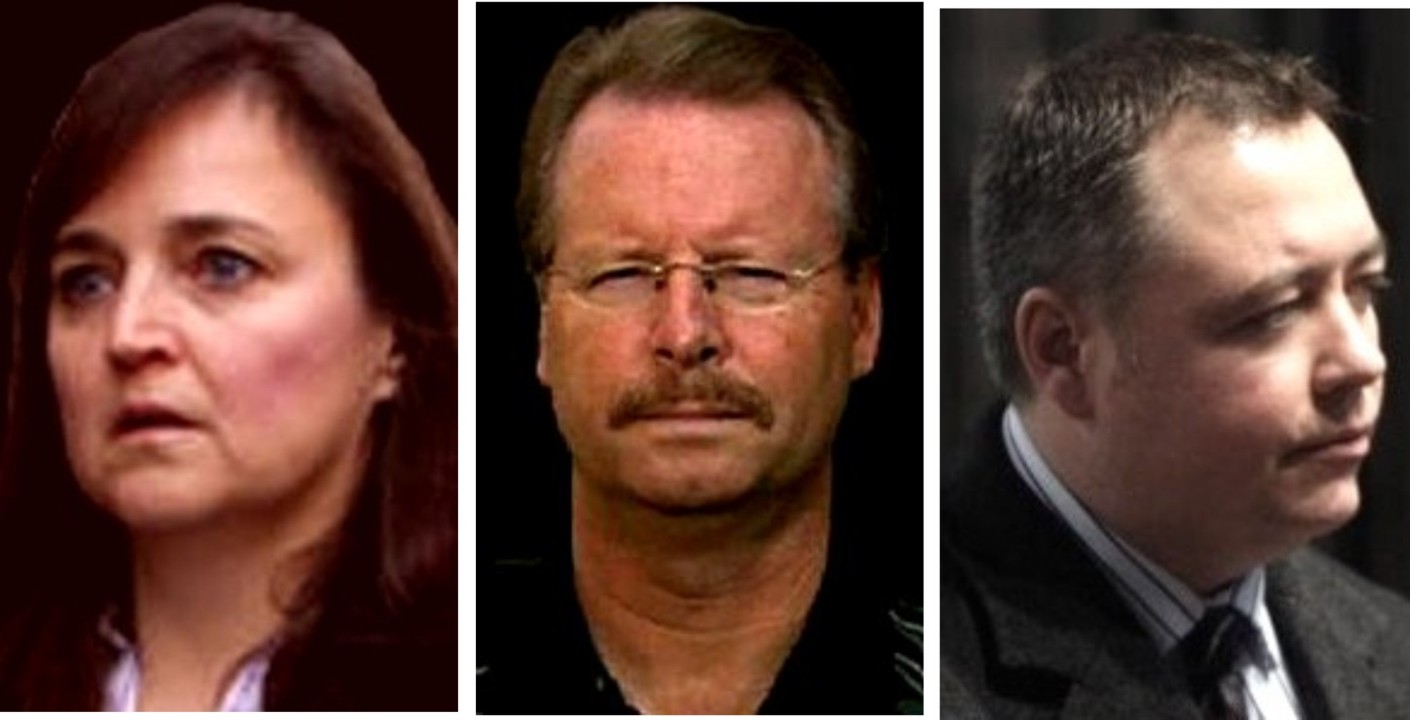
[Edda Mellas, Curt Knox and Chris Mellas might be among those knee-deep in the soup]
Already investigations were under way into a PR campaign that in Italian juidicial terms seems little difference from a criminal enterprise.
Now Judge Nencini has included strong complaints in his sentencing report about nefarious behavior. This might now set a number of people to wondering if they have painted felony targets on their own backs, though the seriously dopey ones may have to have it spelled out for them.
This summary of the complaints is from Andrea Vogt’s excellent report in The Week/First Post which also highlights the appeal findings.
1. Interference with the courts
...during the course of Knox’s long and drawn out judicial process, Judge Alessandro Nencini claims, serious attempts were made to tamper with evidence in a way that would favour her….
In the scathing report that spells out the evidence, logic and reasoning that led to his guilty verdict in Florence on 30 January, Judge Nencini also says Knox and her defence tried to tamper with evidence and pervert the truth by introducing prisoners as witnesses, whose testimony turned out to be false and induced by “other interests”.
“It is clear how this trial was subject to heavy evidence tampering, both internally (slander) and externally,” Nencini writes.
He calls the media interest in the case “fertile ground” that led a number of witnesses to give misleading testimony in exchange for their moment in the limelight.
He also slams the first appeal court’s independent experts for having been oddly superficial and illogical in their analysis of the DNA evidence, especially regarding the potential for contamination, noting that controls were in place to prevent it….
2. Vilification campaign post 2011
Knox and Sollecito were released from prison in 2011 after an appeals court sensationally acquitted them of nearly all charges (one charge against Knox stuck: the slander of Congolese pub owner Patrick Lumumba, who she initially blamed for the crime).
The acquittal ruling, however, was later annulled by Italy’s Supreme Court and a second appeal trial in a jurisdiction outside Perugia was ordered. By that time Knox was safe and sound back in Seattle and chose not to return to Italy for her Florence appeal, instead emailing a statement to the judge, proclaiming her innocence. Sollecito attended.
On 30 January, Judge Nencini and a lay panel of jurors issued a guilty verdict and handed down an even harsher sentence: 25 years for him and 28.5 years for her.
Knox went on national television back in the US the following day claiming, as she always has, that she continues to be the victim of a gross miscarriage of justice carried forward by inertia by dozens of Italian judges.
But in his report, Nencini suggests the gross miscarriage was by Knox and her defence lawyers: indeed, he gave her a longer jail sentence precisely because of the gravity of the slander against Patrick Lumumba aimed at getting investigators off her back.
A small group of fervent supporters continue to lobby on Knox’s behalf and earlier this month she attended an Innocence Project conference with other exonerees, even though Italy’s courts have upheld her convictions….
With this latest development… there appears little wriggle- room for either Knox or Sollecito. Italy’s Supreme Court is expected to give the final ruling on the case after September.
This post was about Amanda Knox’s seriously surreal appearance at that conference of the Innocence Project.
We will soon post a helpful roadmap to all the other numerous suggestions of nefarious behavior on which we have posted. We dont mean to isolate out just Edda Mellas, Curt Knox and Chris Mellas.
Amanda Knox with her highly defamatory website and new charges pending for her book is one of the worst offenders.
Sunday, April 27, 2014
Knox & Sollecito Actions In The Week Prior To Arrest: An Incriminating Behavior Pattern For Sure
Posted by James Raper
[Video above: Sollecito slams Knox’s weird behavior, while not explaining numerous examples of his own ]
1. Today’s Context To This Post
A very strong case for guilt has been made at trial and endorsed at the first-level appeal.
This series hammers home the growing hundreds of incriminating stark differences between the official evidence record, Sollecito’s and Knox’s two books, and Sollecito’s and Knox’s multiple conflicting claims since.
The focus of this post as with the one immediately below is upon the described behaviours of Knox and Sollecito, from the very beginning to this very day. This pattern has more than contributed to the certainty of their involvement in the murder of Meredith Kercher.
2. How The Behavior Speaks To Guilt
The early pointer of the staged break-in aside this behaviour gave investigators an insight into the pair’s possible involvement back on Day One: Behavioral pointers have continued on a par with corroborated developments in the case.
It has even continued, incredibly, since their release from prison. For me it is the thread that runs through this case having as much to do with the overall picture of culpability as the other elements .
This behaviour - to include what they have to say for themselves - is a catalogue of the inappropriate, of the implausible, of inconsistencies and contradictions, of evasions and obfuscations, to be gleaned from the accounts of Knox and Sollecito themselves and highlighted in the accounts of other witnesses. It is also to be gleaned from phone and computer records.
Taken together it is a formidable body of evidence which goes to character and culpability. It cannot be attributed to a railroading job, the machinations of a corrupt and evil prosecutor or character assassination by the media. It is also implausible if not impossible to explain it as being due to naivety, confusion or some quirkiness of character.
It amounts to the pair of them concocting stories, telling lies and misleading investigators and the general public.
3. Physical Evidence Array Is Already Substantial
There are numerous items of evidence which are building blocks in the prosecution case and with which we are all familiar.
- 1. The staged break-in via Filomena’s window with pointers to this outside, on the windows and shutters, and throughout the bedroom.
2. The evident partial clean up proved by footprint trails with footprints missing and what was behind the locked door.
3. Amanda Knox’s lamp on the floor behind Meredith’s locked door which she only conceded was her own at trial, under pressure.
4. Knox’s dried and congealed blood on the tap in the small bathroom that Amanda Knox and Meredith shared.
5. The bloody footprint on the mat in that bathroom definitively attributed to Sollecito rather than Guede
6. The mixed DNA of Knox and Meredith Kercher found in blood in the basin, the bidet and on the box of Q tips in that bathroom
7. Two luminol enhanced mixed traces containing DNA belonging to Knox and Meredith Kercher, one in the corridor and the other in Filomena’s room
8. Two luminol enhanced footprints of Knox in the corridor and one of Sollecito immediately outside Meredith’s room.
9. The knife taken from Sollecito’s apartment with Meredith Kercher’s DNA on the blade and Knox’s DNA on the handle and on the blade
10. Meredith Kercher’s bra clasp with Sollecito’s DNA on a hook and contamination possibilities definitively ruled out.
4. Behaviors In The First Week Of November 2007
I don’t want to make this an unduly long post. Accordingly I am going to concentrate on the period up to that famous police interrogation analysed just below. As to that critical period I will be selective but it should be enough.
The Lady With The Mop?
The story (in Knox’s e-mail) that she had visited the cottage to collect a mop, have a shower and get a change of clothing, earlier on the morning of the 2nd November, but did not notice that Filomena’s window had been broken and her room trashed is just that - a made up story. It is entirely implausible and the account unreliable for a number of reasons including-
- (a) it is hard to believe that she did not notice the hard to miss fact that the shutters to Filomena’s window were (as they were found) open - this would have alerted her to the likelihood that Filomena was back home which she would, of course, have checked out of curiosity if nothing else given that she found no one home.
(b) her claim that Filomena’s door was shut is contradicted by Sollecito who wrote (prison diary) that when he later entered the cottage with Knox Filomena’s door was wide open.
(c) it is hard to believe that she took a shower without noticing until after her shower (as she claimed) that there was blood on the bathroom mat, including a bloody footprint. In fact she didn’t even claim to notice that it was a footprint despite the fact that it was obviously so.
(d) it is hard to believe that having found the front door wide open and having found blood, and having opted for a shower and to blow dry her hair, she never got round to checking for any sign of Meredith’s presence. Any one else would have tried her door to check whether or not she was home.
(e) from her appearance at the cottage that morning it is hard to believe that she took a shower at all (let alone blow dried her hair) and the cops remarked that she reeked of body odour.
(f) less problematic but nevertheless still somewhat surprising is that as she is drying her hair she makes a fuss over shit (left by Guede) in the toilet, describes herself as being “uncomfortable” about it but does not flush it away before grabbing the mop and leaving.
The Two Stayed At Home?
The story that Knox and Sollecito had spent the previous night (the night of Meredith’s murder) indoors, critically from 9 pm onwards, that both had slept and that Knox had been the first to rise at about 10.30 am the next morning is implausible and uncorroborated, not only because this alibi is directly contradicted by the testimony of Curatolo and Quintavalle, and Sollecito’s statement to the police that Knox had gone out and not returned until about 1 am, but also in view of the following facts.
- (a) Curatolo claimed to have first seen the Knox and Sollecito in Piazza Grimana shortly after 9.30 pm but Knox claimed in her trial testimony that she and Raffaele had cooked and eaten a meal between 9.30 and 10 pm.
GCM: Can you say what time this was?
AK: umm, around, umm, we ate around 9.30 or 10, and then after we had eaten, and he was washing the dishes, well, as I said, I don’t look at the clock much, but it was around 10. And”¦he”¦umm”¦well, he was washing the dishes and, umm, the water was coming out and he was very bummed, displeased, he told me he had just had that thing repaired. He was annoyed that it had broken again. So”¦umm
LG: Yes, so you talked a bit. Then what did you do?
AK: Then we smoked a joint together”¦”¦we made love”¦..then we fell asleep.
Unfortunately Sollecito’s father himself torpedoed this dodge by telling the court that when he phoned his son at 8.42 pm Sollecito had told him that there had been a water leak while he was washing the dishes. Taking into account Knox’s testimony that they had eaten before the dish washing, this places the meal and dish washing before that call.
(b) Sollecito told the police that at about 11 pm he had received a call from his father on his land line. Not only is that not confirmed by his father but there is no log of such a call.
(c) There is no log of a call to his mobile at that time either though his father had sent a text message at that time but which Sollecito did not receive until 6. 03 am the following morning. We know that he had received it at that time because that is the time at which it is logged in the phone records. Sollecito had just turned his phone on and clearly the phone had been off when the text message was sent.
(d) There is no record of any phone activity for either of them from after the 8.42 pm call to, in Sollecito’s case, receipt of that text message at 6.03 am, and in Knox’s case her call to Meredith’s English phone at 12.07 pm the next day.
A further word about this Point (d) here as Knox has released her phone records on her web site. In her case it has to be said that this is not so unusual. Up until the 30th October there is no regular pattern of late or early morning phone activity.
It is interesting to note, however, that as of the 30th October there is a spate of texts and calls between her and a young Greek known to us as Spiros. Communication between them had in fact been going on since the beginning of October but there are 5 texts in the afternoon of the 30th, two telephone calls in the afternoon and a call at 11.38 pm on Halloween.
In the early hours of the following morning there are a couple of calls between the two. In fact we know that the two met up together for Halloween as Knox was at a loose end. Meredith had shrugged her off and Raffaele was attending a friend’s graduation dinner out of town.
Sollecito is different as his father was in the habit of calling at all hours just to find out what his son was doing and, as we know, he had called late only to find that his son’s phone was switched off.
In the case of Knox she admitted in any event that her phone had been switched off, “to save the battery”.
(e) There is no record of any activity on Sollecito’s computer after 9.15 pm and until 5.32 am the following morning when music was played for half an hour. This contradicts the claim that Sollecito had smoked pot and interacted with his computer until midnight and that they had both slept until late the following morning.
(f) The fact that the next morning, outside the cottage, both Knox and Sollecito looked utterly exhausted. This belies the alibi that they had spent a quiet night indoors and had only risen late that morning.
The Fake Call To Knox’s Mum in Seattle?
Knox falsely claims in her book that having had her shower she called her mother on her way back to Sollecito’s apartment as she was beginning to have concerns as to what she had seen at the cottage. Her mother tells her to raise her concerns with Raffaele and the other flatmates and Knox says that she then immediately called Filomena. Filomena tells her to get hold of Meredith by phone which she tries to do by calling Meredith’s English phone first, then her Italian one.
- (a) How does this correlate to the contents of her e-mail of the 11/04/07?
(b) How does this correlate to Knox’s phone records?
(c) There is no mention of a call to her mother at all in the e-mail. This from her e-mail -
“”¦.and I returned to Raffaele’s place. After we had used the mop to clean up the kitchen I told Raffaele about what I had seen in the house over breakfast. The strange blood in the bathroom, the door wide open, the shit in the toilet. He suggested I call one of my roommates, so I called Filomena”¦”¦”¦..
Filomena seemed really worried so I told her I’d call Meredith and then call her back. I called both of Meredith’s phones the English one first and last and the Italian one in between. The first time I called the English phone it rang and then sounded as if there was disturbance, but no one answered. I then called the Italian phone and it just kept ringing, no answer. I called the English phone again and this time an English voice told me the phone was out of service.”
(d) the phone records are as follows for 2 November 2007:
Ist call of the day @ 12.07.12 (to Meredith’s English phone) - 16 seconds
2nd call @ 12.08.44 (to Filomena) - 68 seconds
3rd call @ 12.11.02 (to Meredith’s Italian phone) - 3 seconds
4th call @ 12.11.54 (to Meredith’s English phone) - 4 seconds
8th call @ 12..47.23 (first call to her mother) - 88 seconds
(e) The discrepancies are numerous, see these examples:
1. The first call to her mother was not just after leaving the cottage but 40 minutes after the call to Filomena, and the call to Filomena had been placed after she had returned to Raffaele’s place and after they had used the mop and had breakfast. In fact, say about an hour after she left the cottage.
2. The first call to Meredith’s English phone was placed before the call to Filomena, and not after as Knox would have it in her e-mail. A minute before, but Knox did not mention this to Filomena, as confirmed by the e-mail and Filomena’s testimony.
3. The first call to Meredith’s English phone disappears entirely in Knox’s book.
4. The call to the Italian phone did not just keep ringing. The connection was for 3 seconds and this was followed by a connection to the English phone for 4 seconds.
5. The English phone was not switched off or out of service. Mrs Lana’s daughter had found it. She said that she would not have done so but for it ringing (the 12.07 call for 16 seconds?). She picked it up and took it into the house where it rang again (the 12.11 call - 4 seconds?). A name appeared on the screen as it rang : “Amanda”.
6. The 3 and 4 second calls are highly suspicious. The Italian phone was undoubtedly in the possession of the postal police. According to Massei it’s answering service was activated, accounting for the log. Clearly Knox did not even bother to leave a message for Meredith as it would take longer than 3 seconds just to listen to the answering service. This is not the behaviour of someone genuinely concerned about another.
- Observations:
1. In her e-mail, and repeated in her trial testimony, Knox says that she woke up around 10.30 am, grabbed a few things and walked the 5 minutes back to the cottage. If the first call to her mother was about an hour after she left the cottage (see before), then she left the cottage at about 11.47 am, which means that she spent over an hour there. Either that or she spent more (a lot more) than 20 minutes at Raffaele’s place before calling Filomena. The latter would be more likely as it is difficult to conceive that she spent over an hour at the cottage. She didn’t have the heating on when she was there. Either way there is a period of about an hour and a half between when she might have tried to contact Meredith or raise the alarm and actually doing so.
2. That we are right to be incredulous about this is borne out by the false claim in Knox”˜s book. That false claim is significant and can only be because Knox is aware of the problem and feels she needs to add some support to her implausible story of the mop/shower visit and to conceal the real reasons for the inactivity and delay connected with it.
3. That it is incredible is even belatedly acknowledged by Sollecito’s feeble but revealing attempt to distance himself from Knox in a CNN interview on the 28 Feb this year. “Certainly I asked her questions” he said. “Why did you take a shower? Why did you spend so much time there?”
4. That she makes that false claim and has constantly stonewalled and/or misplaced the 16 second call to Meredith’s English phone is indicative of her guilty knowledge. Her guilty knowledge with respect to the 16 second call was that it was made to ascertain whether or not the phones had been located before she called Filomena, and hence for her it was not (incredulous though this is without such explanation) a pertinent fact for her to bring up with Filomena.
The Real Call To Knox’s Mum In Seattle?
As to the 12.47 call to her mother itself (4.47 am Seattle time and prior to the discovery of Meredith”˜s body) Knox not only did not mention that in her e-mail but in her trial testimony she steadfastly declined to recall that it had occurred.
She clearly did not want, or could not be trusted, to discuss why the call had occurred and what had transpired in conversation with her mother before the discovery of Meredith’s body.
Not only was the timing of the 12.47 call inconvenient to her mother but I found it interesting to note from Knox’s phone records (covering 2nd Oct - 3rd November) that mother and daughter do not appear to have called or texted each other once up until that 12.47 call.
It would appear then that in so far as they remained in direct communication with each other for that period it must have been by e-mail. One can therefore imagine that her mother was very surprised to receive that call.
It is also very difficult to accept that Knox could not recall a phone call she was not in the habit of making. (On the other hand the same records show that it was not at all unusual for Knox and Meredith to communicate with other on Meredith’s English phone.)
Sollecito’s Call From His Dad?
At the cottage, and prior to the above call, Sollecito received a call from his father at 12.40 am. Do we know what they discussed? It would in any event have been after the discovery of Filomena’s broken window and (allegedly) Sollecito’s (rather feeble) attempt to beak down Meredith’s door.
Did the responsible adult advise his son to do the obvious and call the police? One would think so, but then why was there a 10 minute delay before he called his sister in the Carabinieri at 12.50 am? Indeed, why call his sister at all? Filomena had also urged Knox to call the police when she called at 12.35.The delay might be explained by the unexpected arrival of the postal police and if this was the case then it was before Sollecito called the 112 emergency services.
The Claims Of Finding Meredith’s Body?
Neither Knox nor Sollecito saw into Meredith’s room when the door was broken down and her body discovered on the floor under a quilt. Yet in the immediate aftermath it is as if they have wanted others to believe that it was they who discovered her body and in the bragging about this there have been disclosures, not only as to what they should not have been aware but also suggestive of disturbed personalities. This behaviour was remarkable for all the wrong reasons.
- (a) Luca Altieri”˜s testimony makes it clear that Knox and Sollecito had heard about Meredith”˜s cut throat directly from him during the car ride to the police station.
However her bizarre and grotesque allusion in the early moments of the investigation to the body being found stuffed into the closet (wardrobe) is not just factually incorrect (it was lying to the side of the closet) but bears correlation to the later forensic findings based on blood splatter in front of and on the closet door, that Meredith had been thrust up against the closet after having been stabbed in the throat.
(b) The behaviour of Knox and Sollecito at the police station is documented in the testimony of Meredith’s English girlfriends and of the police. Whilst it is true that people react to grief in different ways it is difficult to ascribe grief to Knox’s behaviour. Emotionally she was cold towards Meredith’s friends and occasionally went out of her way to upset them with barbed and callous remarks.
The fact that Knox was not observed to cry and wanted to talk about what had happened is not of itself indicative of anything but remarks like “What the fuck do you think, she bled to death” and her kissing and canoodling with Raffaele (including them making smacking noises with their lips when they blew kisses to each other) in front of the others was not normal.
Rather chilling in retrospect was a scene between the pair of them when Knox found the word “minaccia” ( in english - threat) amusing and made a play of it with Sollecito in front of witnesses.
(c) Grief is in any event reserved for friends and relations, or people one much admires. The evidence is that the initial short friendship between the two had cooled to the extent that Meredith was studiously, if politely, avoiding being around Knox. For the narcissistic and attention seeking american girl this would have been difficult to ignore and may well have offended her.
(d) The next day Sollecito was willingly collared by a reporter from the Sunday Mirror and told her about the horror of finding the body.
“Yes I knew her. I found her body.”
“It is something I never hope to see again,” he said. “There was blood everywhere and I couldn’t take it all in.”
“My girlfriend was her flatmate and she was crying and screaming, ‘How could anyone do this?’”
Sollecito went on to tell the reporter that “It was a normal night. Meredith had gone out with one of her English friends and Amanda and I went to party with one of my friends. The next day, around lunchtime, Amanda went back to their apartment to have a shower.”
About the only thing that is true here is that he knew Meredith.
Wednesday, April 16, 2014
The Incriminating Bathroom Evidence: Visual Analysis shows the Footprint IS Sollecito’s
Posted by Machiavelli
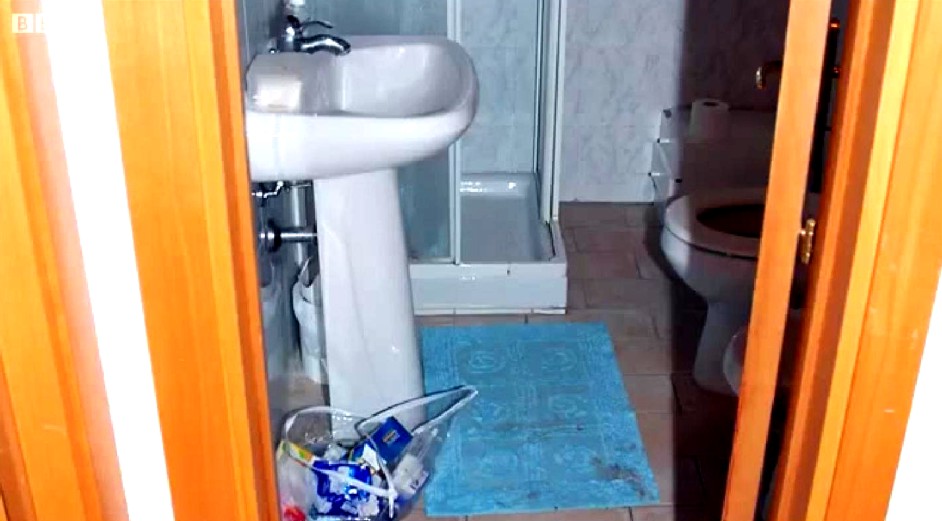
[Please click on each image for a larger and more high-resolution version]
The sheer depth and width of the hard evidence
The defenses really don’t want you to know this: in both width and depth, the full panoply of the evidence against Knox and Sollecito is absolutely overwhelming.
As we remarked in our post below there are far more and far stronger evidence points than UK and US courts normally require for conviction. But only the trial panel of judges observed anything like their full array.
The 2010 Massei Trial Report (which the Nencini Appeal court validated this past January) is a SUMMARY of what was presented to the judges in the courtroom. Those presentations in court were in turn something of a SUMMARY of the hard evidence buried in all the evidence files and the minds of witnesses.
Italian media SUMMARISED for Italians what was to be seen in the courtroom and to be read in the Massei Report. They were barely able to do even summaries for the 1/4 of all the trial hearings that were not open to the media or the public.
UK and US media for the most part didn’t even bother to provide comprehensive summaries (the very fine on-the-spot reportings of Andrea Vogt, Barbie Nadeau and Ann Wise were the main exceptions).
So in effect people in the UK and US attempting to follow the story didnt for the most part receive even a summary of a summary of a summary!
Not one US or UK newspaper or TV network translated the Micheli Report, or the vital Massei Report, or the Supreme Court appeal, or the Supreme Court outcome - only the (mostly professional) translators on PMF dot Org did all that translation.
This post is another example of how far down - beyond even Massei - it’s possible to drill into the evidence, and see it still hold up.
Some past posts on TJMK drilled down to similar depths, on the knives, on the DNA, on the mixed-blood traces, on the phone-events, on the motives and psychologies, and so on. All that evidence too all held up.
Visual analysis of the bathroom-mat footprint
This post mainly consists of high-resolution pictures and measurements. Presented like this, the pictures and measurements largely speak for themselves, and show the real strength of the bathroom-mat footprint evidence.
You will see that as SomeAlibi previously concluded using other methods, this footprint was quite undeniably Sollecito’s. It bears no similarity at all to Rudy Guede’s.
Please click on all images for larger versions in scalable PDF format
1 . [Below] the bathmat and the print, with measurement reference
2 . The bathmat print and the surrounding area
3 . The bathmat print (photo from Polizia Scientifica).
4 . The bathmat print, with vertical and horizontal sizes, from Rinaldi’s report
5. The bathmat print, photo with enhanced contrast.
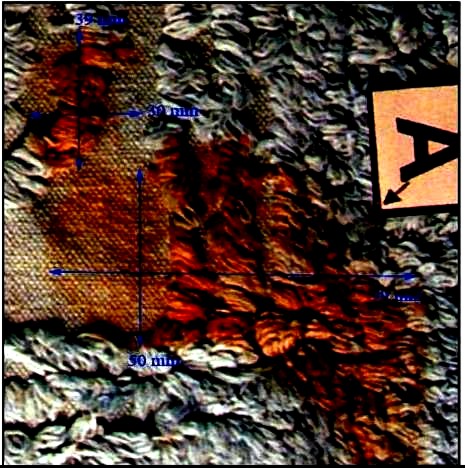
The photo above was modified by highly enhancing contrast.
6 . Enhanced contrast helps to spot some features
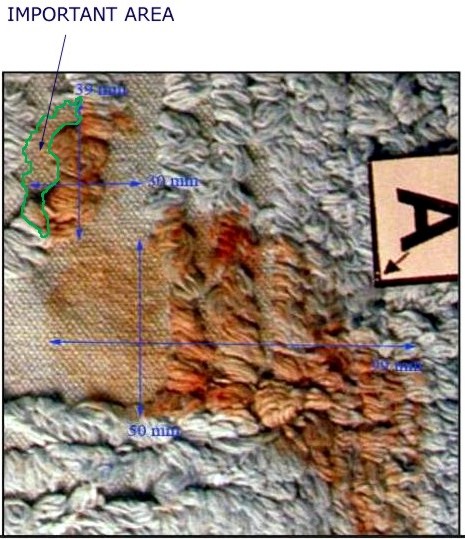
Contrast may help to highlight especially some parts of the print outline.
For example the area on the left labeled as “important area” in the picture (which was “forgotten” in the notorious photo elaborations disseminated by the ‘Friends of Amanda’ group), shows the actual left outline of the “˜big toe’ of the bathmat print.
The toe includes the area indicated in this picture (here the picture is shown again in its original colours).
7. The bathmat, with enhanced contrast
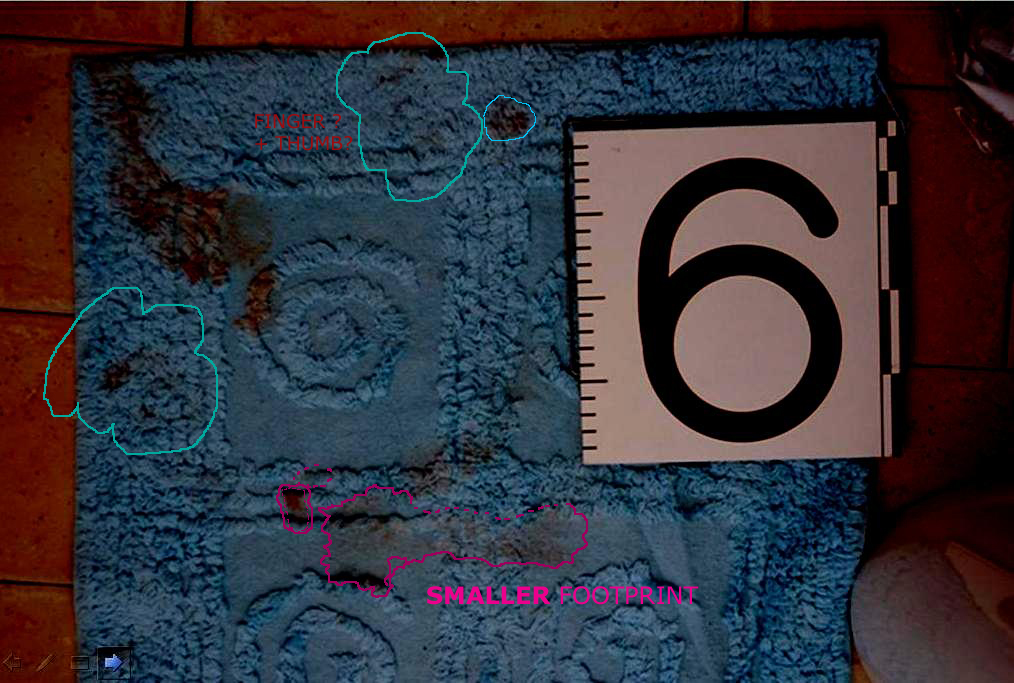
The contrasted image is showing the presence of other stains
There are other stains on the carpet (about another 10, factually situated in one half of the mat area), and also there shows a second diluted footprint (apparently from a foot of smaller size).
8. The selection of a set of red colour shades, outlined by an automatic outline generator
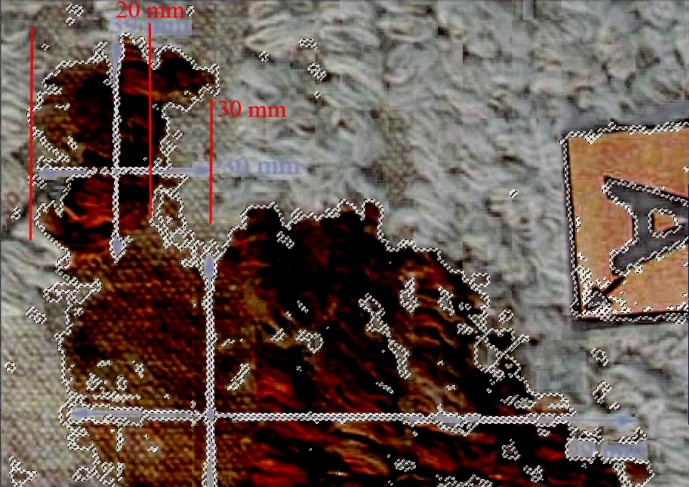
Shows the shape and the possible “˜outline’ of the stain
Reference measurements indicate the width of the “˜big toe’ in millimetres.
9 . A hand drawing of the outline (detail).
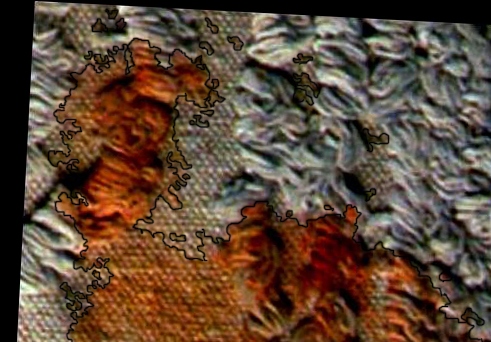
The photography above was modified
The modifications are: +28% contrast, -8% luminosity, + 20% colour saturation, from the original.
An outline has been drawn manually on the photoshop image, trying to be as faithful as possible to the actual stain.
You can notice that, apart from some minor “˜disputable’ very faint areas (such as the area between the toe and the metatarsus) there are only minimal differences between an automatically generated outline and a manually drawn one.
The shapes of the “˜big toe’ are extremely similar in both contours (images 8 and 9), in fact all meaningful features are basically identical.
We consider this manually drawn outline as good for comparison.
10 . The complete hand-drawn outline
11 . Minor detail: small dots separated from the main stain

Observe the small red ‘dots’ in the picture above
Although we can’t draw any conclusion about their possible significance, we note the existence of these very small “˜spots’ of a faint red colour shade, separated from the big stain.
They are detected by the computer generated outline above, and that we also see as distinguishable with the naked eye thus we considered them in drawing manually the outline.
We don’t draw any conclusion about them; but because of their sensitive position (they may suggest a “˜small toe’ mark) we take note of them.
The green arrows in the picture point out their position (green circles).
12 . An image in electronically modified colours
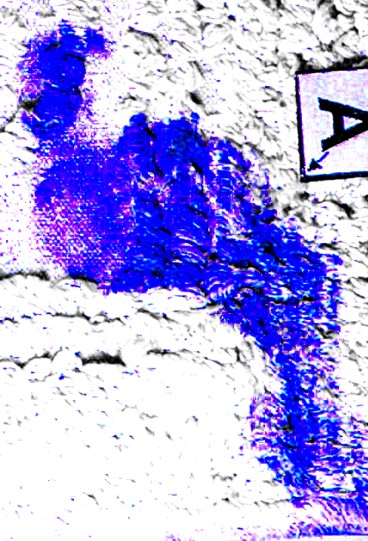
Distribution and intensity of the colouration
As a part of the preliminary study of the stain, we also produced this image above where the computer assigned an artificial colour to an array of shades of ‘red’, thus allowing to further isolate the stain from the background for further assessments about its shape.
This picture shows the distribution and intensity of the colouration. (note: the existence of some above mentioned tiny marks is recorded by this technique too)
13 . The bathmat has a spiral-shaped relief decoration
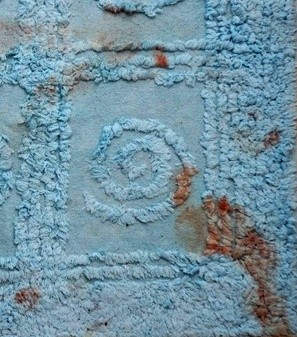
The footprint’s toe obviously balancing on top of the relief decoration.
We think the outline of the “˜toe’ mark of the bloody footprint is affected by the shape of the decoration, in particular the missing part of the toe on the right side, which is remarkably coincident with the margin of the decoration.
So that on that side there is a striking correspondence between the outline of the “˜negative area’ ““ the fabric surface around the spiral, which is lower ““ and the big toe’s outline
This indicates that the outline of that mark on that side was affected by the decoration margin, thus the print there has a “˜missing part’. So the “˜crooked’ bloody area in fact follows the margin of a larger toe.
Because of such coincidence, we can logically assume that the actual shape of the big toe mark appears to be part of a big toe, with larger surface which left its print only partly because part of its surface did not have contact with the fabric, in correspondence of the “˜negative area’.
14. The “negative area”
15. Mat decoration in relief and the toe mark
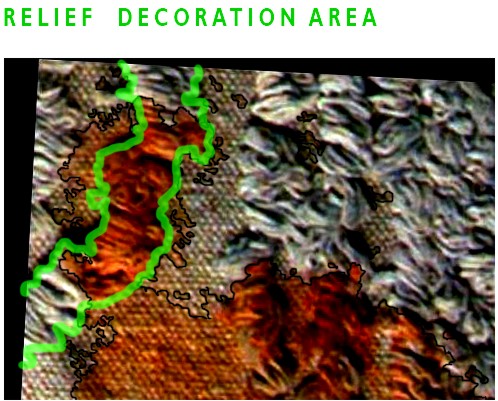
Observe above one single, unitary stain
The remarkable coincidence between the outlines of the decoration in relief and of the toe mark is shown in the picture above.
The rough contour of the print obtained through a smooth curve highlights the shape of the big toe.
Part of the relief decoration outline coincides with the toe mark outline, which shows, highlights and explains how all parts of the red toe mark, that you can see left of the relief decoration, they all belong to one single, unitary stain.
Thus we can deduce that the “missing” area on the right of the toe is determined by the decoration, and coincides with the negative area.
16. Picture (by Kermit) showing a rough shape of the stain
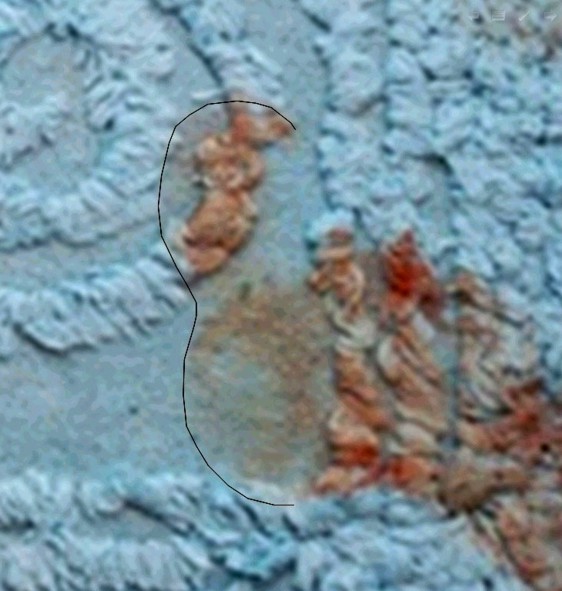
Observe shape, curvature and size
This drawing by Kermit above highlights the rough shape, curvature of left margin and overall size of the big toe.
17. Rudy Guede’s sample print
A copy of this picture together with one of Sollecito’s print at the same scale will be used for comparisons.
18 . Raffaele Sollecito’s sample print
A copy of this picture together with one of Guede’s print at the same scale will be used for comparisons.
19. Part of Rudy Guede’s sample print with Rinaldi’s reference measurements
20. Part of Sollecito’s sample print, with Rinaldi’s reference measurements:
21. Bringing all photographs down to the same scale
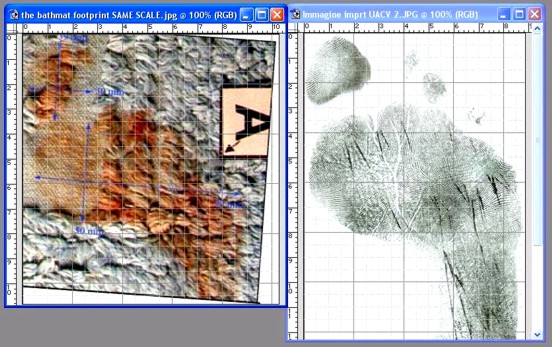
An accurate exercise of scaling was done
This was based on Rinaldi’s referenced pictures. Each one of the Rinaldi’s sample pictures has multiple measurements on several points of reference which allow a high precision determination of their scale and sizes, and thus comparison at the same scale.
In order to further increase scaling precision, the scale was calculated previously and separately for each comparative measurement in the three photos; this was done multiple times for each measurement and the average was picked in order to reduce error as for statistical measurement method.
The resulting final error in the scale is extremely small, far below a threshold of significance that could affect comparison (which was set arbitrarily at 1%, but it’s probably significantly higher, while the actual error is much lower).
In other words, the scale error that may affect your screen pictures will be definitely smaller than any possible perceivable (either significant or tolerated) difference that would be noticed or that may affect the attribution of the stain, when this is compared to the sample.
22. The hand drawn outline is shown again here
23 . The outline (matched scale) overlapped on Sollecito’s sample footprint
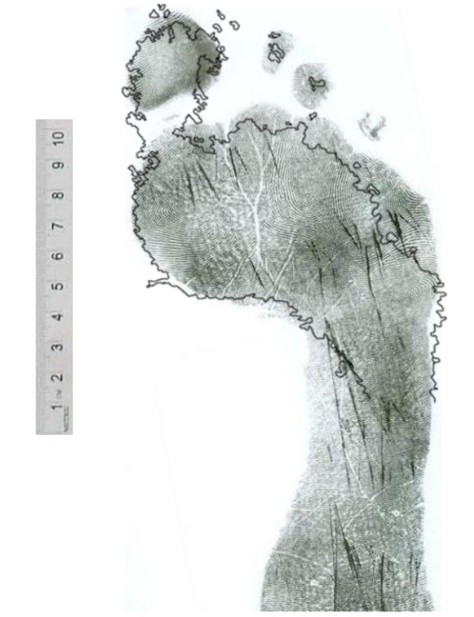
The array of compatibilities with Sollecito
The bathmat stain does not seem to have major incompatibilities with Sollecito’s print; it shows rather an array of compatibilities that can be perceived visually.
One interesting feature is the shape, size and position of a ‘big toe’, that appears as a remarkable coincidence; the toe also has a kind of cleft (see 28 below) on the curvature of its left margin. Another outstanding coincidence is the curvature of the plantar arch on the left.
24 . The same outline overlapped on Guede’s footprint
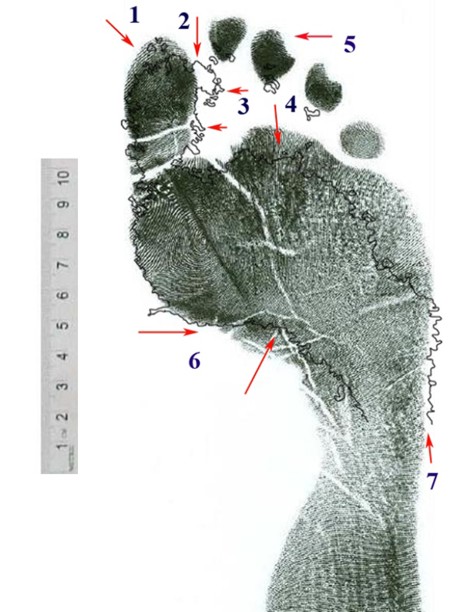
Compare with Guede’s - matched scale.
If you look at the overlapping of the stain outline (see pic 22.) with the sample of Guede’s print (see pics 17. 19.), you may notice 7 major differences, showing a failure of compatibility. Those differences are indicated by numbers (1-7) in the picture .
Each one indicates an area of major difference between the outline of the bathmat stain and the outline of Guede’s sample print. Those measurement differences are remarkably larger than those that can be detected on the overlapping with Sollecito’s sample print.
On the other hand, the compatibility between Sollecito’s print and some very peculiar aspects of the bathmat print (such as a 30mm wide and short toe) were absolutely remarkable.
The differences between the bathmat stain and Guede’s print are :
1) Toe mark of stain is significantly SHORTER than the big toe in Guede’s sample print (a difference of about 7 millimetres). Some people may want to attempt an objection, by suggesting that such a difference may be just a consequence of the position chosen for the overlapping, that maybe the bathmat print was just positioned too low in the picture, the problem may be solved by shifting it up about 7 millimeters so as to make the tip of the bathmat toe ‘coincide’ with the tip of Guede’s print toe.
However, such objection wouldn’t work; it’s a wrong argument. In fact the only possibly correct position for overlapping the bathmat stain outline is determined by the left curvature of the ball of feet and plantar arch (the area of the picture near number 6), which is by the way the most clearly outlined part of the bathmat stain. If you shift the bathmat stain upwards, the outline will miss the match with the curvature of the left margin of the ball of the feet. You will notice that the plantar arch in this area is already very incompatible with Guede’s plantar arch. It tends to become even more incompatible the more you shift the bathmat stain outline towards the toe.
The problem has no solution, since the more you shift the stain outline upwards (in the direction of the toe) in an attempt to make it look more ‘compatible’ with the length of Guede’s toe (or with an upper margin) the more it will become incompatible with the plantar arch. In order to limit the incompatibility of the plantar arch, and in order to keep an overlapping of at least the left margin of the ball of the feet, you need to place it as shown in the picture, this is the position of ‘maximum’ compatibility between the bathmat stain and Guede’s print. Conclusion: the bathmat toe is too short.
2) Toe mark of stain is TOO WIDE (30 mm). It is much wider (30 mm) than Guede’s toe. The number 2. indicates the protruding mark at the upper right, the mark which Giulia Bongiorno desperately insisted on calling a “second toe” mark. In fact, not only would the mark miss completely any hypothetical Guede’s ‘second toe’ in any possible position of the print; also you may notice (highlighted by pics 8. and 9.) how it is not a “mark” itself, but actually it just part of the same area which is entirely continuous in shape and coloration with the rest of the toe mark, and - the most remarkable feature - its right outline is coincident with the outline of the spiral-shaped relief decoration, so that you can reasonably conclude that it is determined by that (the missing area at the lower right of the ‘big toe’ is determined by the existence of the “negative area” of the bathmat decoration).
Conclusion: the bathmat stain has a wider toe mark, however one likes to call it (“big toe”, or “big toe + second toe”) that fails to match any possible part of Guede’s print. The bathmat print is clearly different and incompatible with Guede’s print. It simply cannot be overlapped to any part of Guede’s sample print. Such area is a very significant difference that points outright to incompatibility between the stain and Guede’s print.
3) The toe mark is larger also in the area located at the lower portion of the toe. The toe of the bathmat print in fact has a ‘right margin’ which actually has some additional small marks, small drops protruding towards the right, like droplets maybe produced by the wet cotton fibres of the part in relief which protrude towards the right. This tends to suggest the toe area of the stain may in fact be considered wider: the object that produced it was definitely wider than 22mm, in this area of the toe as well. So also a look at this area confirms that the bathmat stain is wider than 22-23 mm (more towards 30 mm) not just when measured at the upper corner (number 2.) but also at its “lower” parts; here, the small marks caused by the liquid suggest that a larger surface has squeezed liquid from some fabric threads leaving some trace also on the lower area.
4) Bigger incompatibility of Guede on the metatarsus front outline. This area is the front outline of metatarsus: the stain is almost 1cm shorter than Guede’s metatarsus. This happens when you chose the overlapping so as to make the left outline and plantar arch (6.) of metatarsus coincide, as in the picture. Sollecito’s sample print also shows some difference from the stain in this area (pic. 23.) but the difference between the stain and Sollecito’s print is significantly smaller than what you can see in Guede’s print.
5) There are NO SMALL TOES in the bathmat stain. Small toes are completely absent from the bathmat stain (while the tiny blood marks around the stain don’t coincide with their expected position if it was Guede’s print). Such lack of small toes is a peculiarity of the bathmat print. This is a remarkable difference from Guede’s print, and at the same time, a considerable analogy with Sollecito’s print. In fact one outstanding feature of Guede’s print is the evidence that Guede places a big load of weight on his small toes while instead Sollecito has a posture with a weight distribution with the contrary tendency, and obviously he almost does not touch the ground with his small toes.
Thus, Guede’s small toes are all very well pressed on the ground and thus, we can reasonably infer they are somehow naturally likely to get wet if he steps on any wet surface, and anyway they should get wet for sure if the foot is immersed in water or washed (the foot that left the bathmat print must have been immersed in bloody water). The murderer supposedly washed his foot then stepped on the bathmat. In order to attribute the print to Guede we should assume that Guede “forgot” to touch the carpet with his small toes (while instead he puts a lot of weight on them) or that he managed to not rinse them.
6) The outline of the stain has a PLANTAR ARCH that COINCIDES, by curvature and angle, with the plantar arch in Sollecito’s print, while instead it is very different from the plantar arch of Guede’s print.
7) The stain is larger than Guede’s print metatarsus as visible in the right area of the stain. The difference is rather significant, almost half a centimetre, that is bigger than the difference with Sollecito’s print which instead coincides for a trait. This difference cannot be “solved” in any way since, even if one wanted to claim that the scale is wrong and that the stain should be sized down, this would make the toe, already too short (as in 1.) become even shorter.
If instead the toe length is adjusted the metatarsus becomes even less compatible with Guede. We recall that Massei found that Guede’s feet had a print overall more slender than Sollecito’s.
25 . Other features:
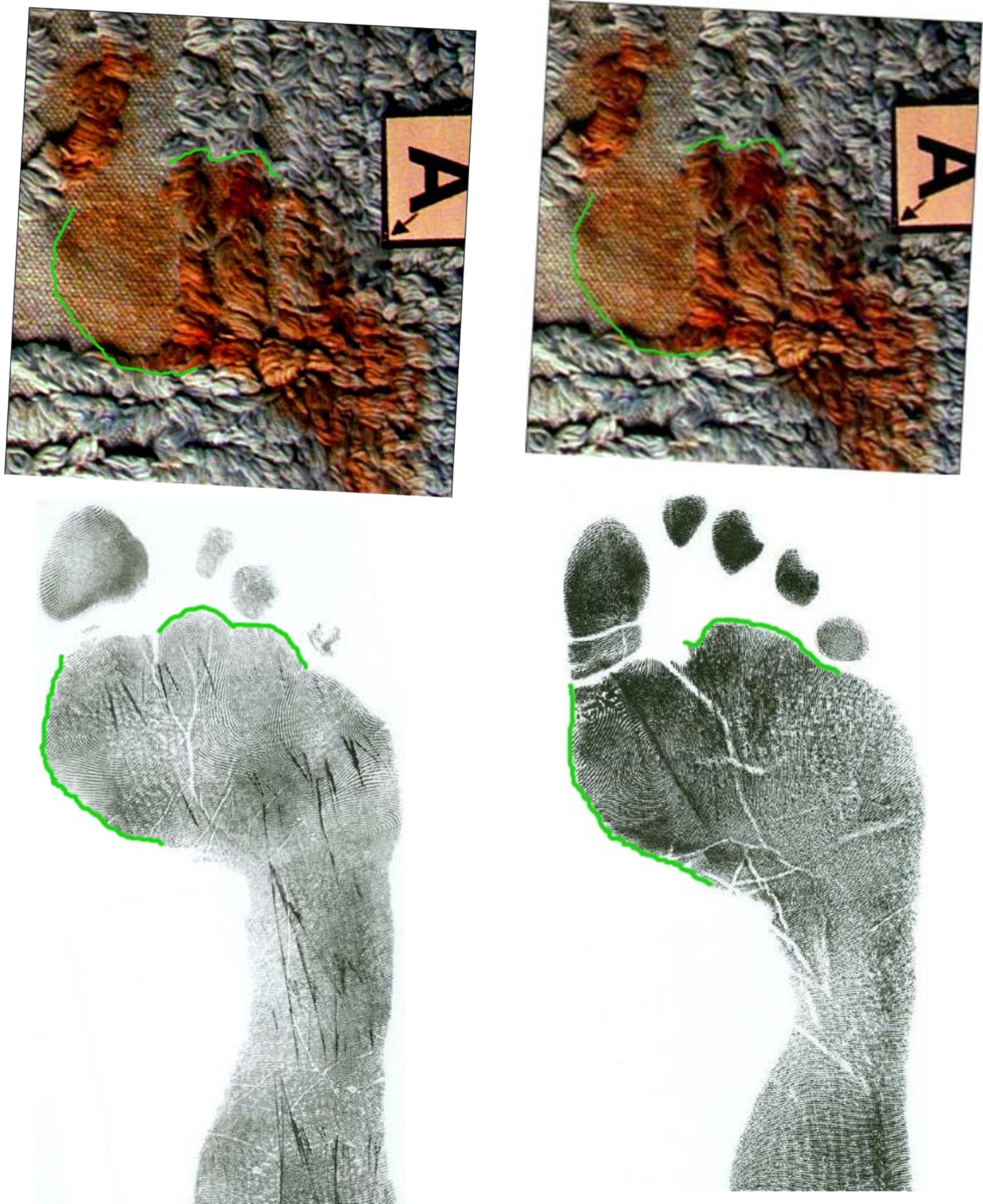
Curvatures of plantar arch are very different
The plantar arch curvature, highlighted in two different drawings (the second highlights also the upper outline “hunches”); the plantar arches in the two sample prints of Sollecito and Guede are shown below. The curvatures of plantar arch are very different.
26. The outline curvature generates different angles
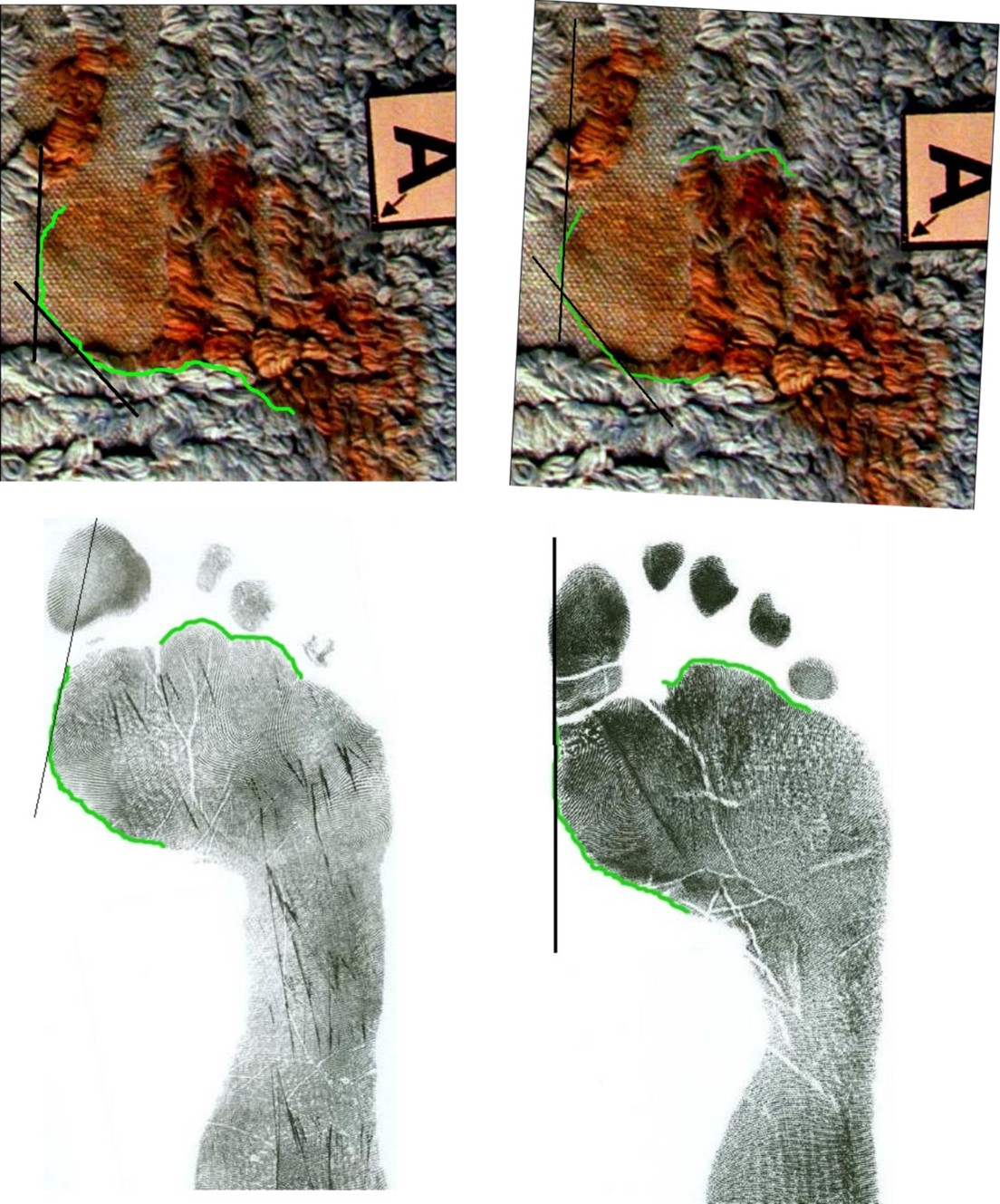
Sollecito’s and Guede’s plantar arch curvatures have very different angles. Also the left outline of metatarsus maintains a different curvature. Sollecito’s outline has an angle (see outline tangent) intersecting the toe (the metatarsus has a “bunion”); in Guede’s print there is basically no intersection, the outline and the toe form almost a straight line.
27 . Plantar arch curvature angle differs between Sollecito and Guede
If you consider the vertical axis of the sample footprint, and its orthogonal line, you may notice how the plantar arch curvatures of the two prints accomplish different angles: the two angles are VERY different, not just three or four degrees.
The (too) narrow angle of Sollecito’s plantar arch probably has a relation with the protruding outline and angle seen in pic 26., and seems related to a hallux valgus (which Guede does not have).
28 . The “cleft” on the left side of the stain
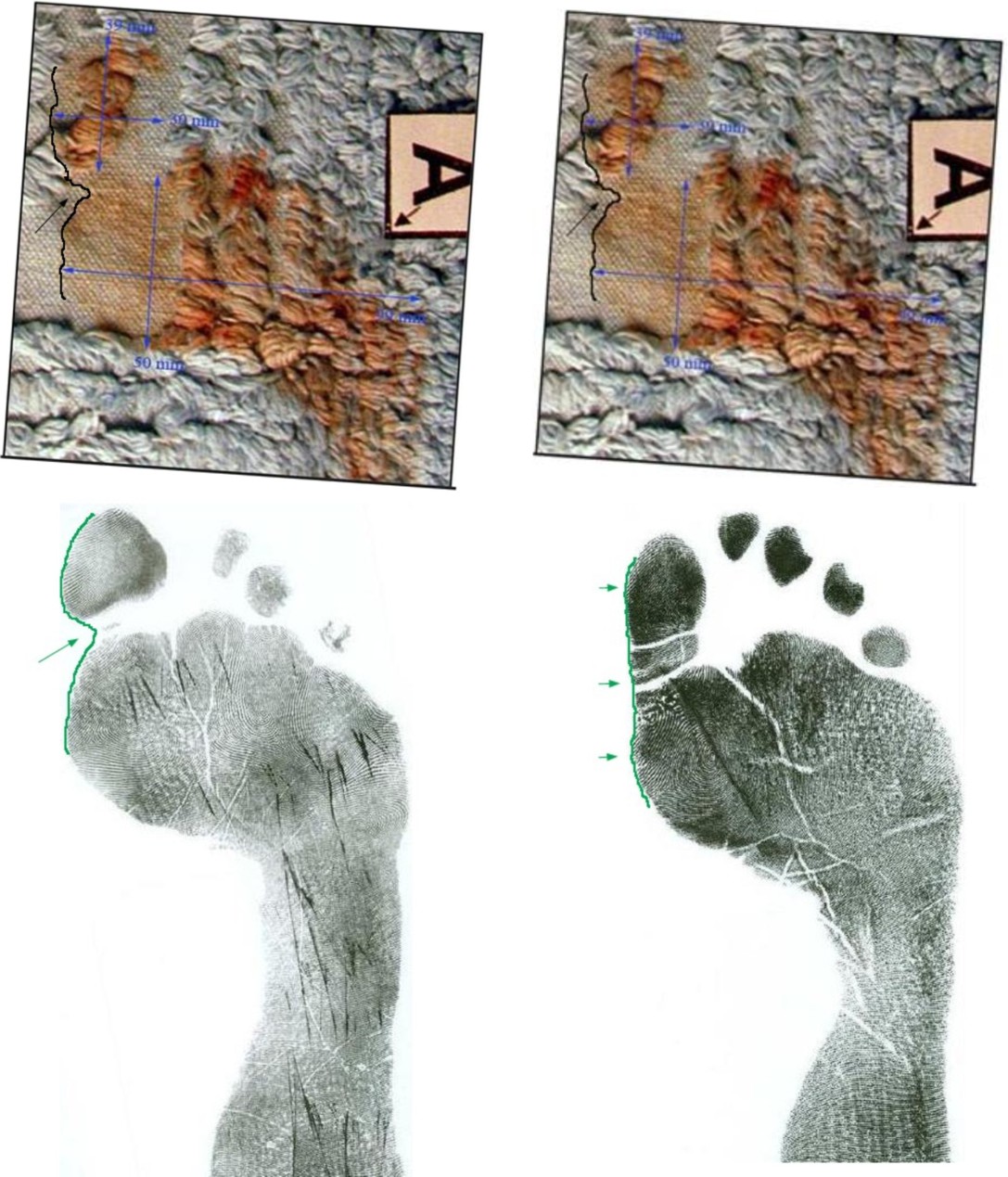
The “cleft” on the left side
This has a correspondence with one sample print, not so with the other.
29 . Table of metric comparison (by SomeAlibi)
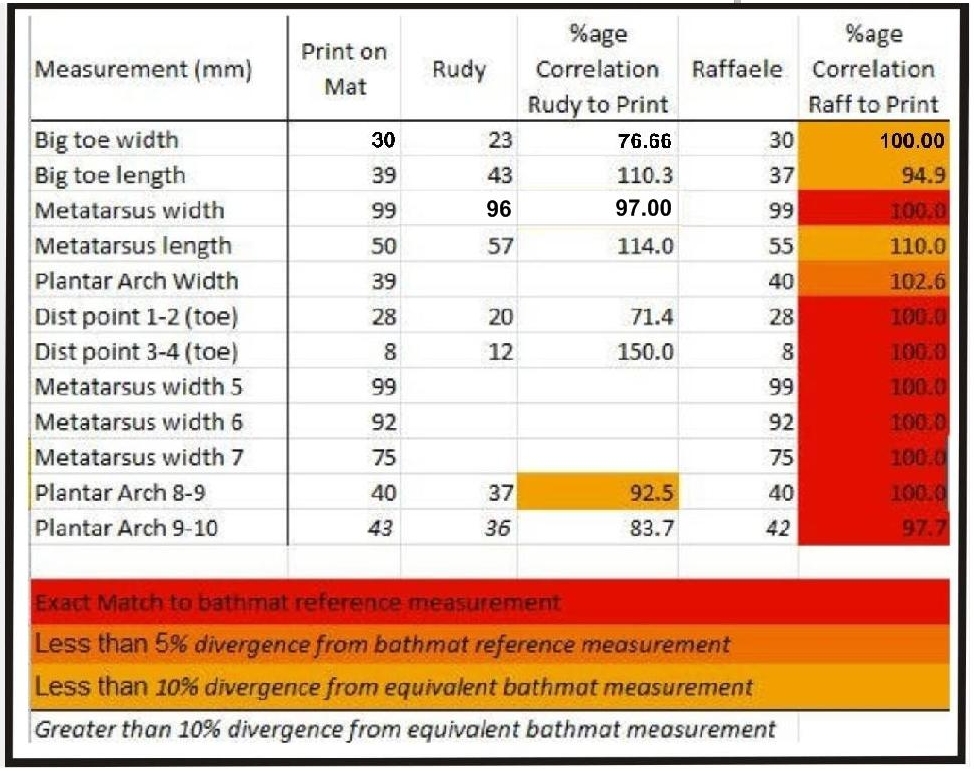
SomeAlibi’s post of a year ago
Comparison of measurements and analysis of correspondence degree of bathmat print, with both Guede’s and Sollecito’s sample prints.
Thursday, April 10, 2014
Sollecito Takes On A New Lawyer To Help Him Work His Way Past The Minefield That Is His Book
Posted by Peter Quennell

Raffaele Sollecito retained Alfredo Brizioli after he burned his trial lawyers in his book
Both Sollecito’s book and Knox’s book seem to have the primary purpose of poisoning public opinion against the courts.
The serious charges Sollecito and Knox will probably face for those books are of three kinds: (1) the contempt-of-court misrepresentation of the Italian justice system itself; (2) the obstruction-of-justice twisting of the evidence in the case; and (3) the claims of crimes committed by numerous career police and prosecution officials.
If false, in effect a gigantic frame-up that leaves Knox’s framing of Patrick in the dust.
At the eighth session of the Florence appeal court back in January, Giulia Bongiorno engaged in a day-long summation which was peculiar, to say the least.
Like Sollecito and Knox in their books, Giulia Bongiorno seemed to be attempting to put the justice system and investigation and prosecution in the dock.
If false, another gigantic frame-up that leaves Knox’s framing of Patrick in the dust.
Bongiorno’s rant didnt seem to help Sollecito in undermining any of the hard evidence in the case, and it left the judges visibly unmoved. But it was notable how closely it resembled the rants on the justice system and its officials by Sollecito himself in his book. See the examples in the post below.
There are some complex later passages in Sollecito’s book and some recurring themes that we will analyse which would seem impossible for Sollecito to write about in such detail without the extensive help of a lawyer who was in the court.
Who precisely was that?
Reports from Italy now state that Alfredo Brizioli, not Giulia Bongiorno, will be the lawyer the Sollecitos choose to respond to the investigating prosecutor’s report on the book. Perhaps Mr Brizioli (who right now is himself on trial for obstruction of justice in another case) can try to negotiate a way for his client to spread the blame before the charges are set in stone.
The Sollecitos seem weak. Alfredo Brizioli seems weak. Giulia Bongiorno seems weak. And Knox also seems weak - if Sollecito is ever going to back away from Knox (perhaps to try to claim the final murderous stab of Meredith was solely Knox’s crazed idea) there is just this one last chance.
We in no way favor Sollecito getting off lightly without recanting. We do want to point to the potential fireworks a smart prosecution has engineered that might help achieve this.
Although there was a sort of bidding war for both books, not every publisher, having seen what was to be in them, was eager to join in. Some did sit on the sidelines.
Withdrawing the two books ASAP might be the smart move. The mood in the book industry in New York, where both publishers have their HQ’s, seems to be that that move could be the wisest.
